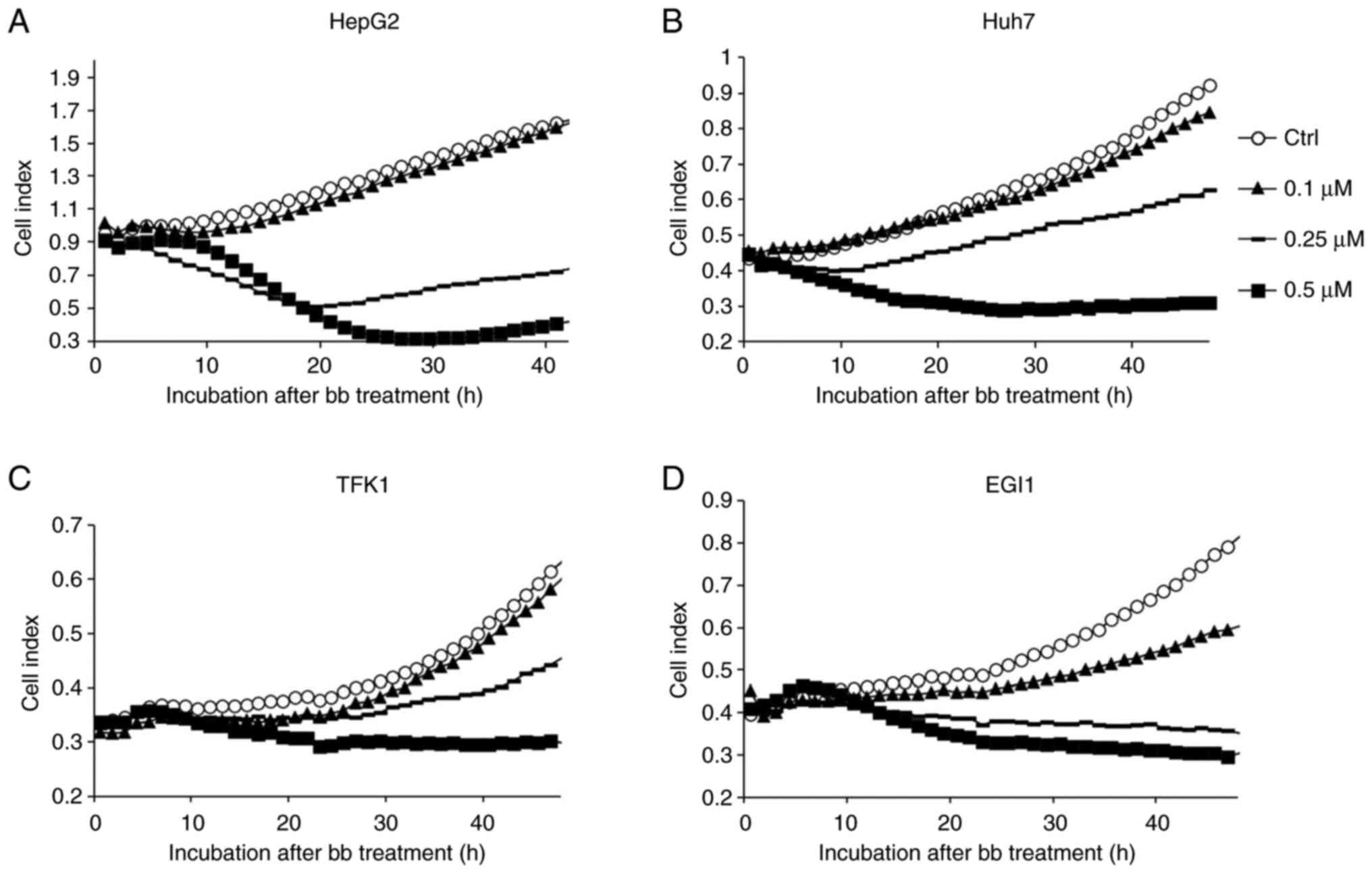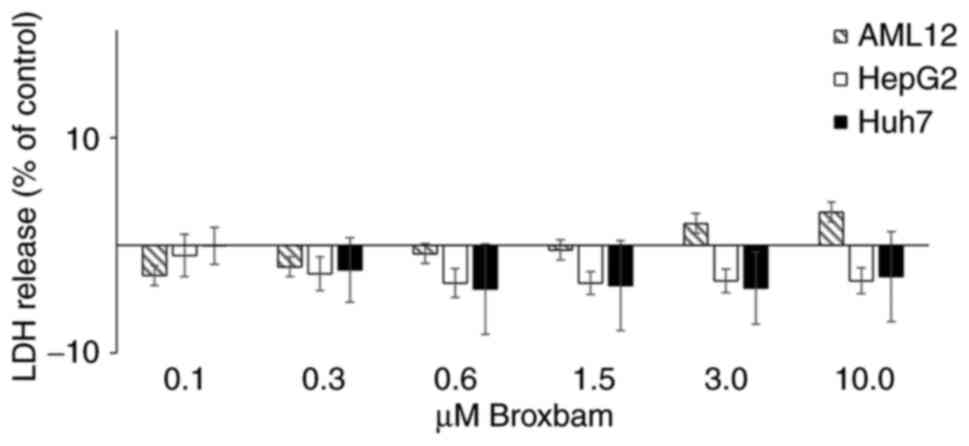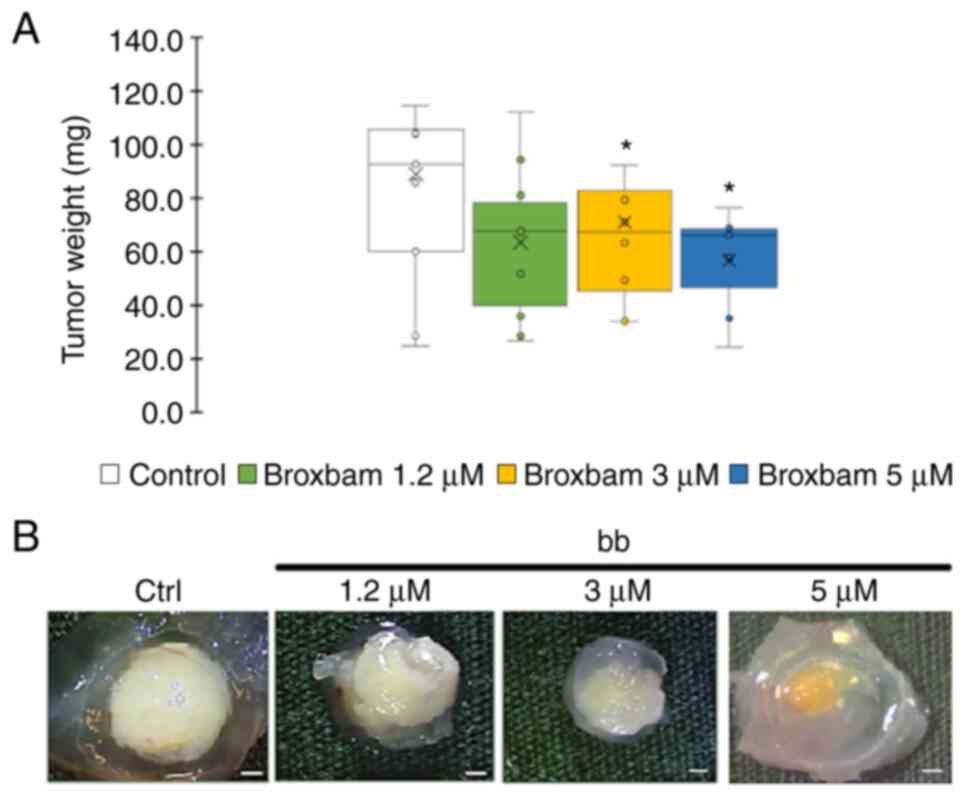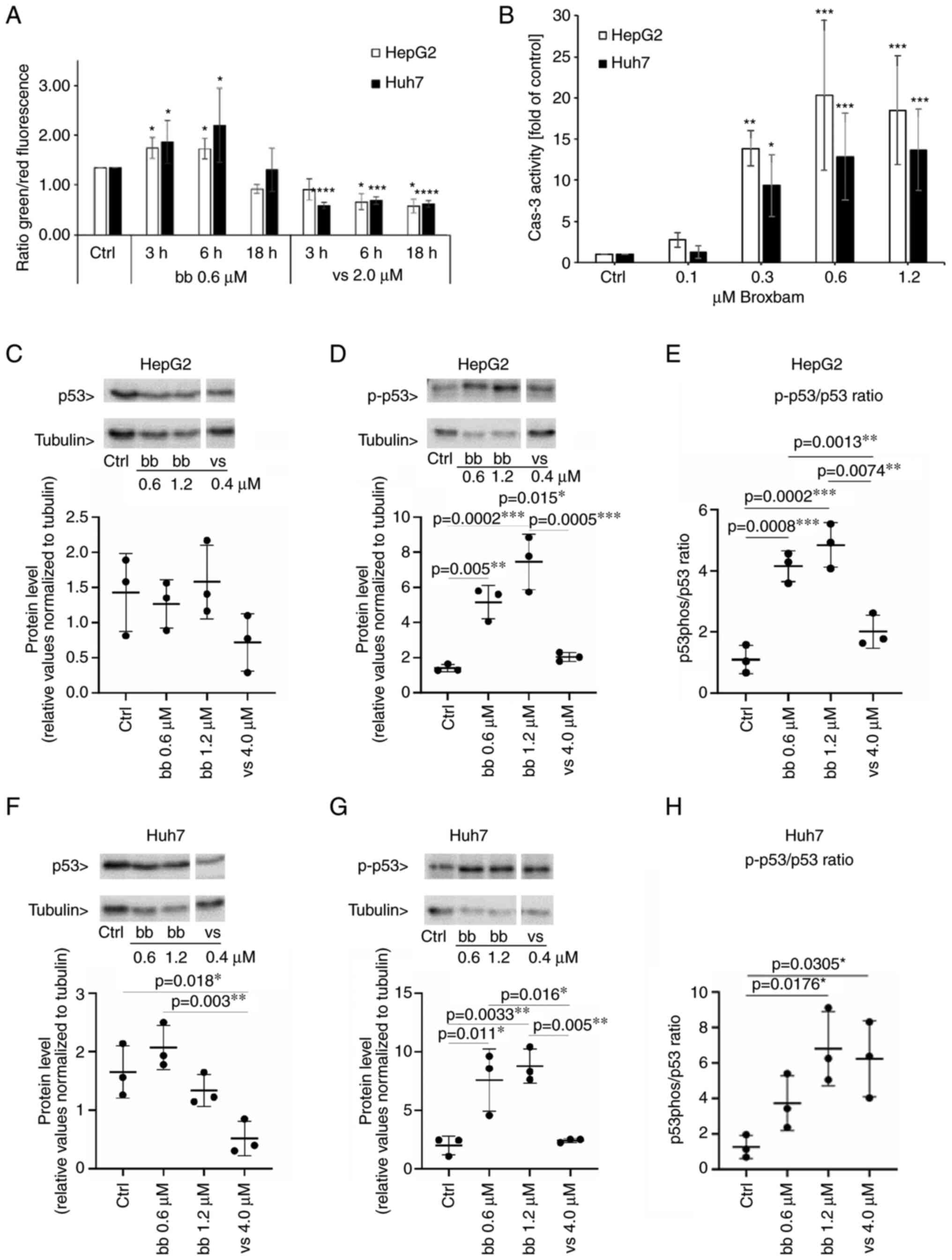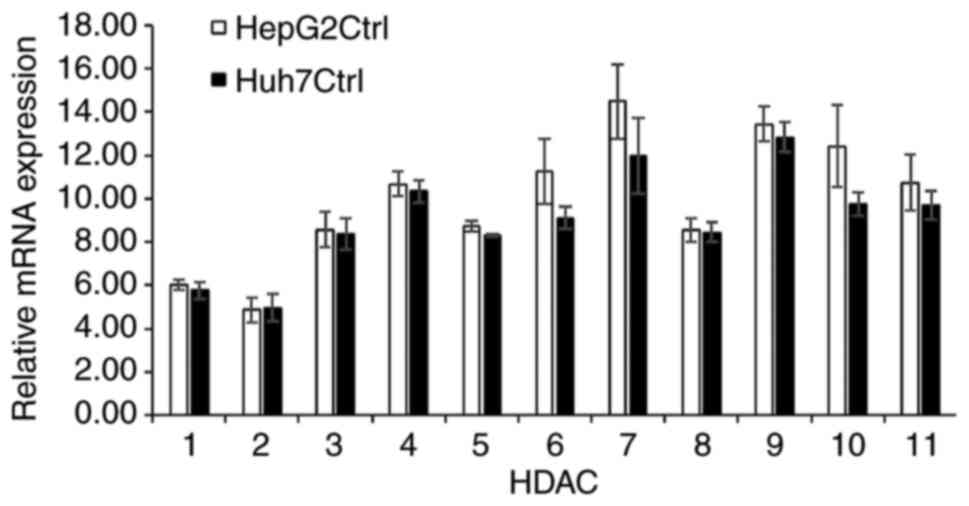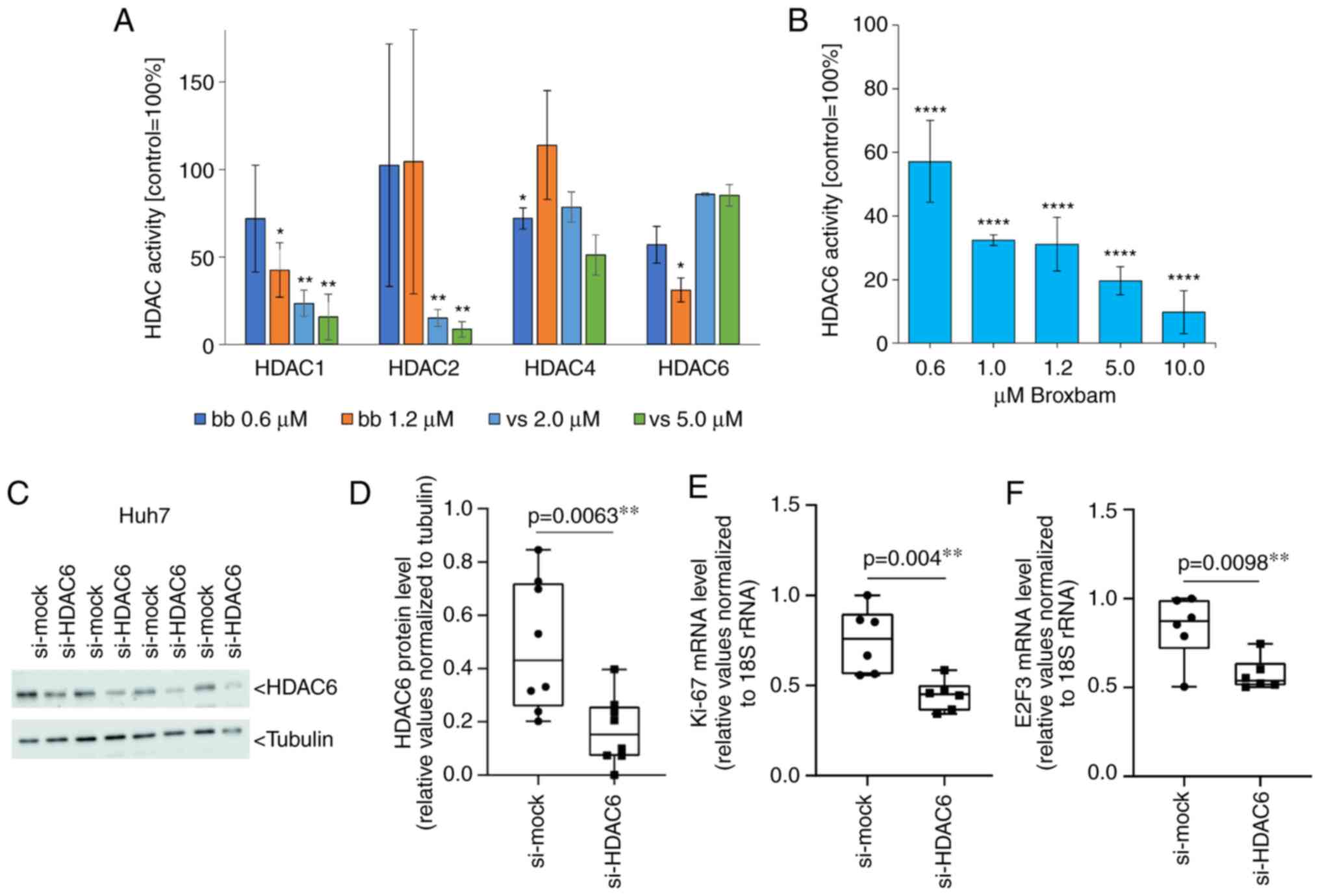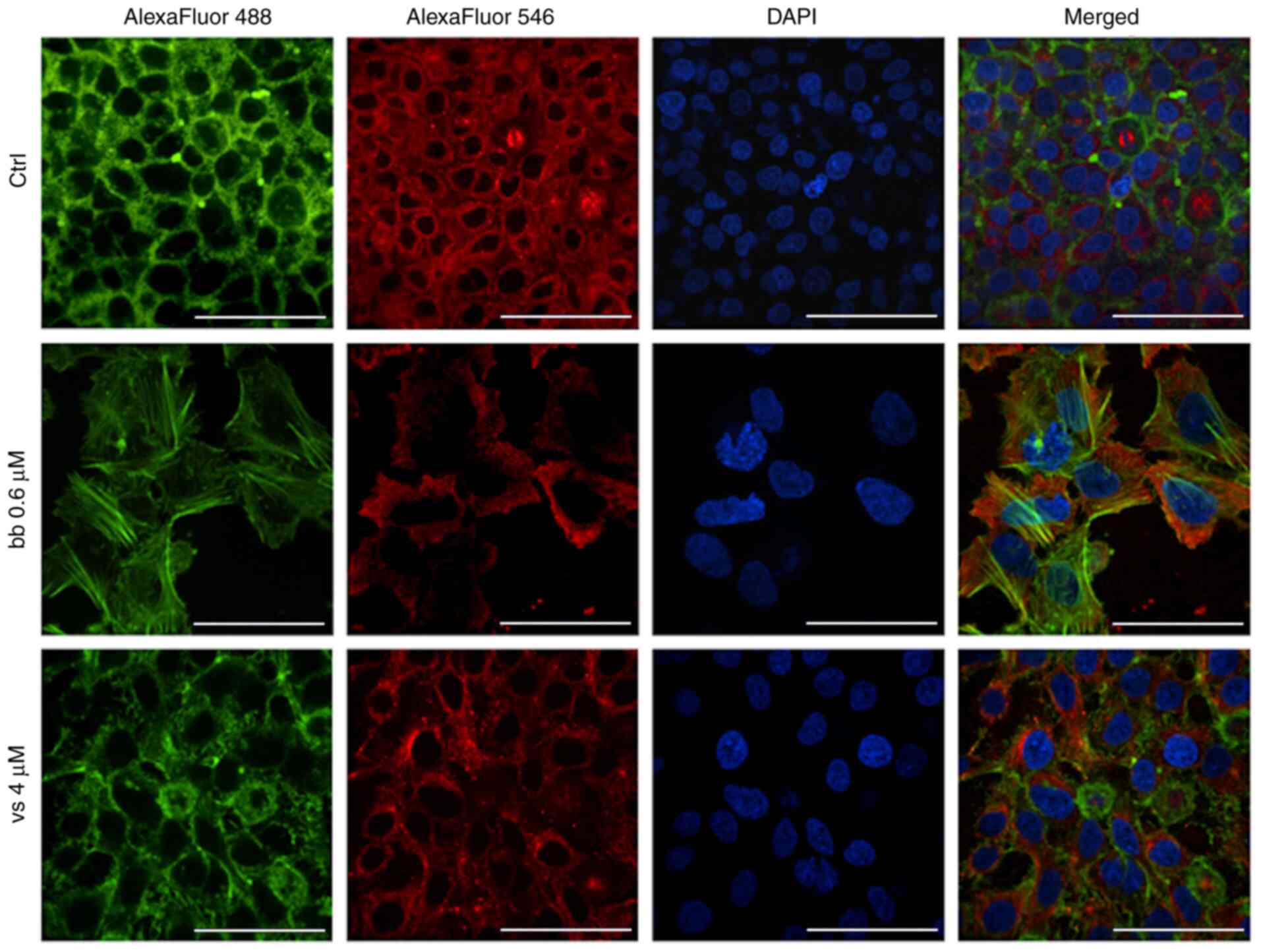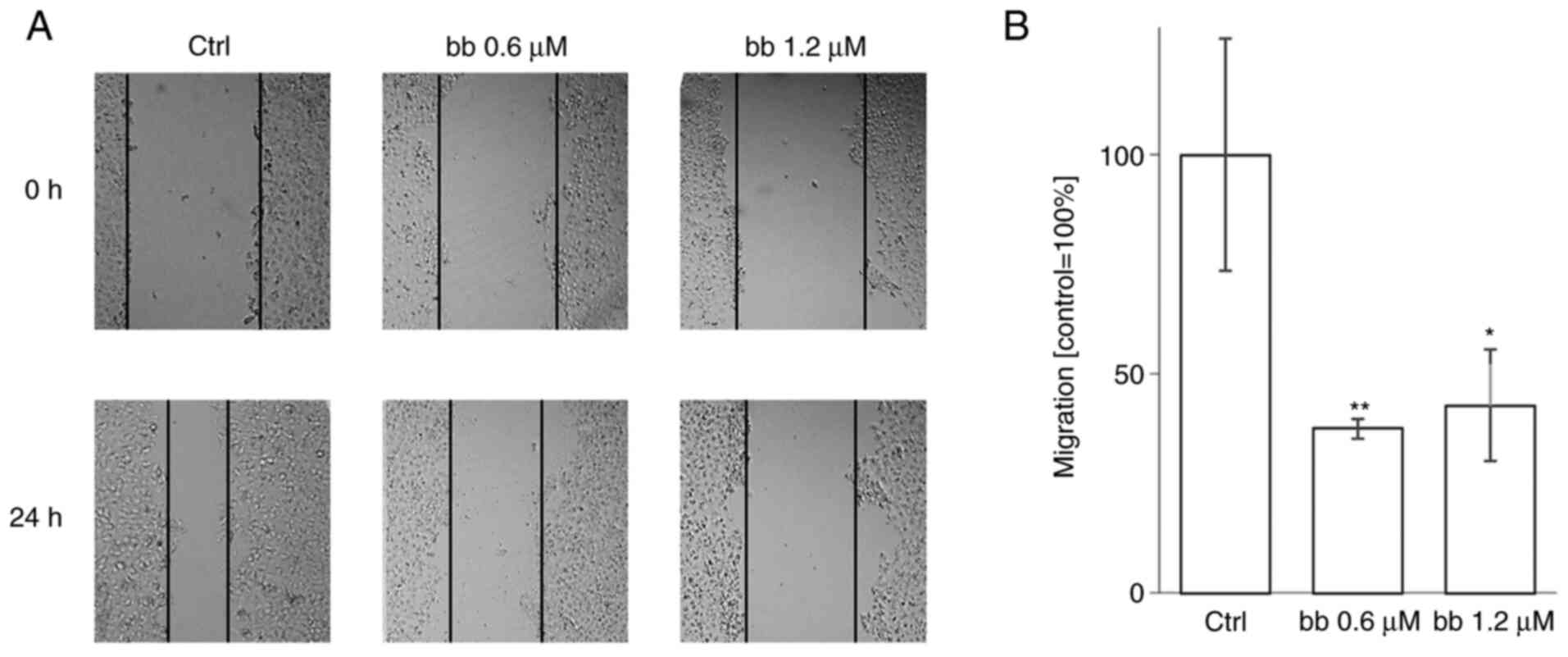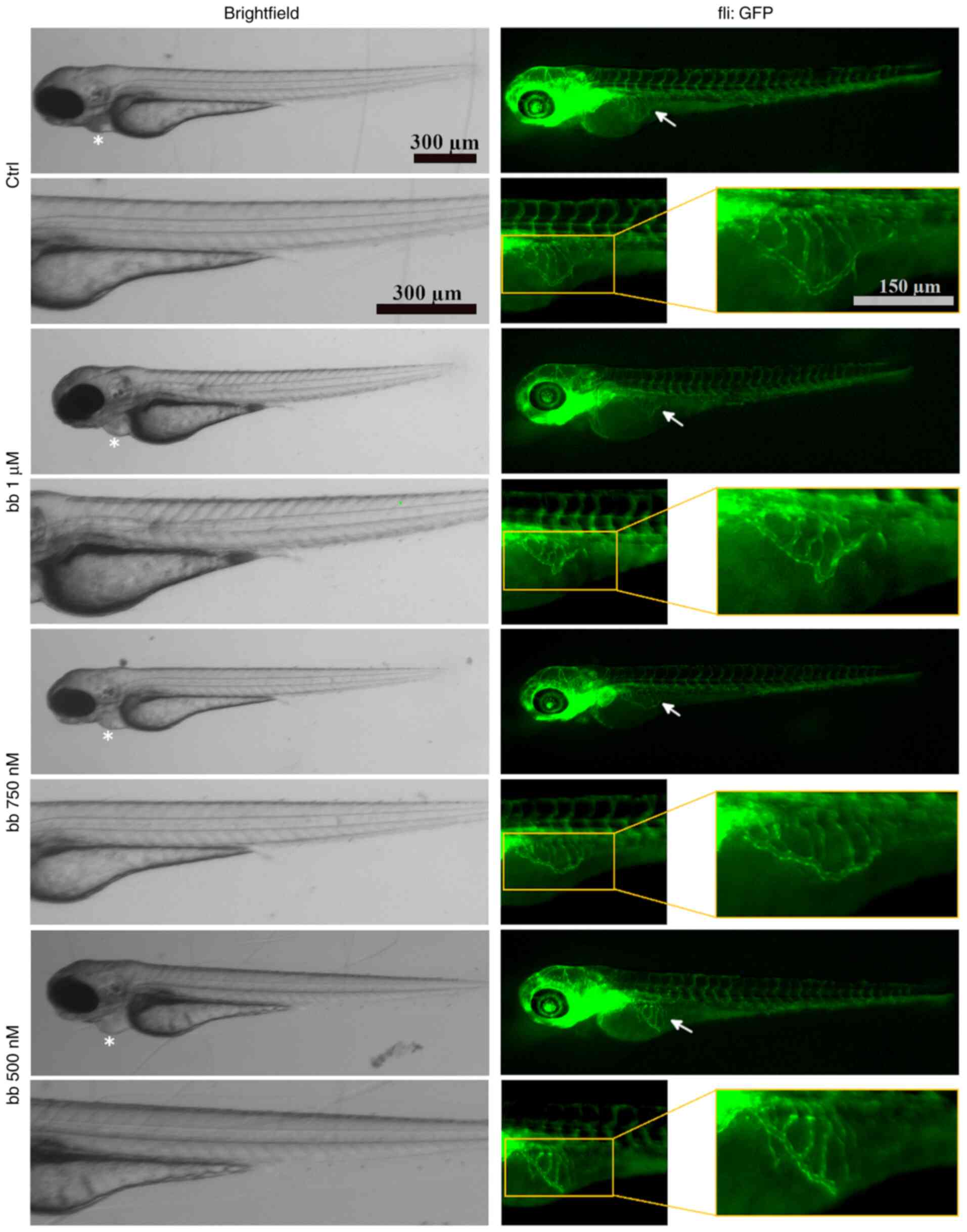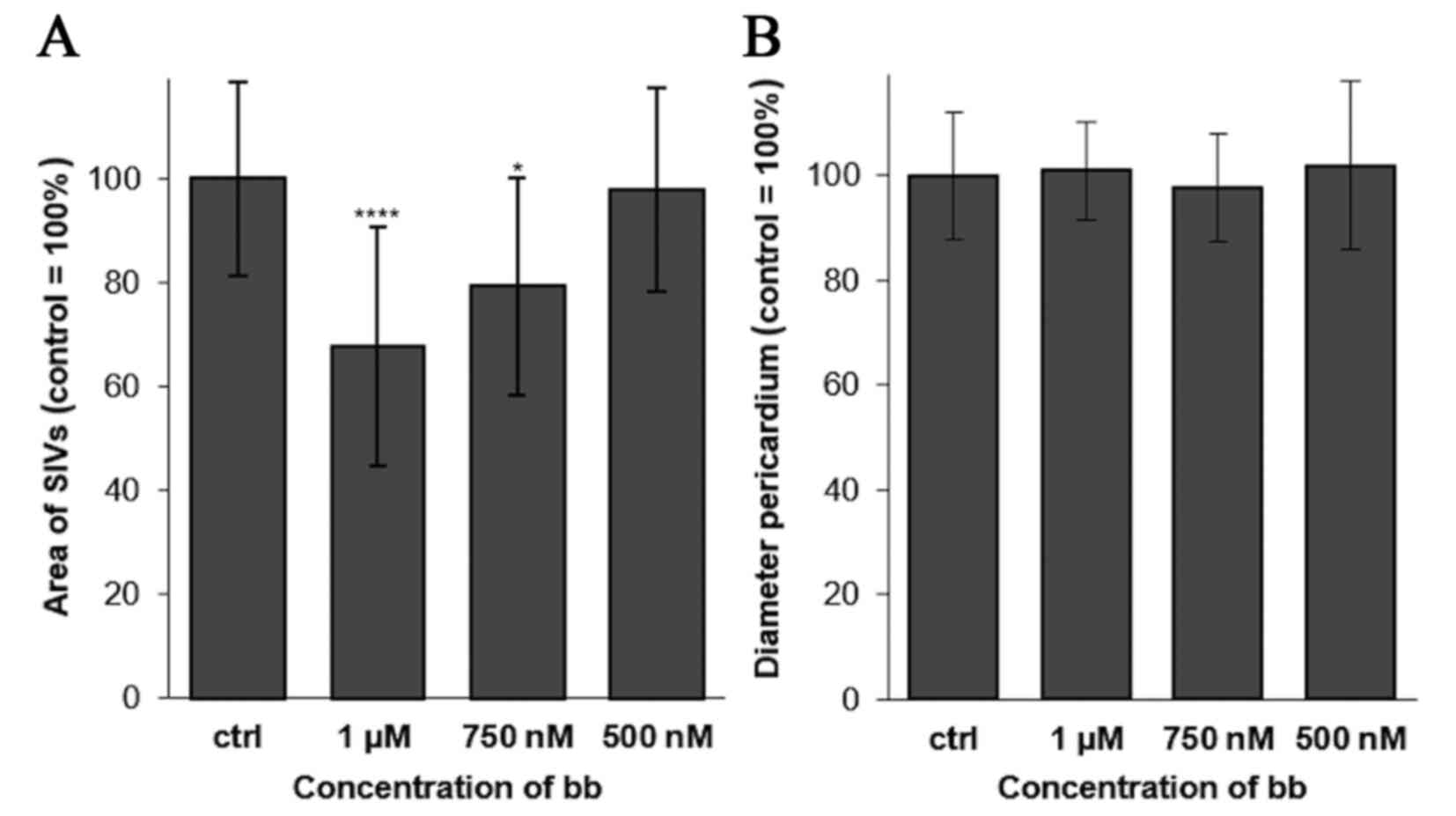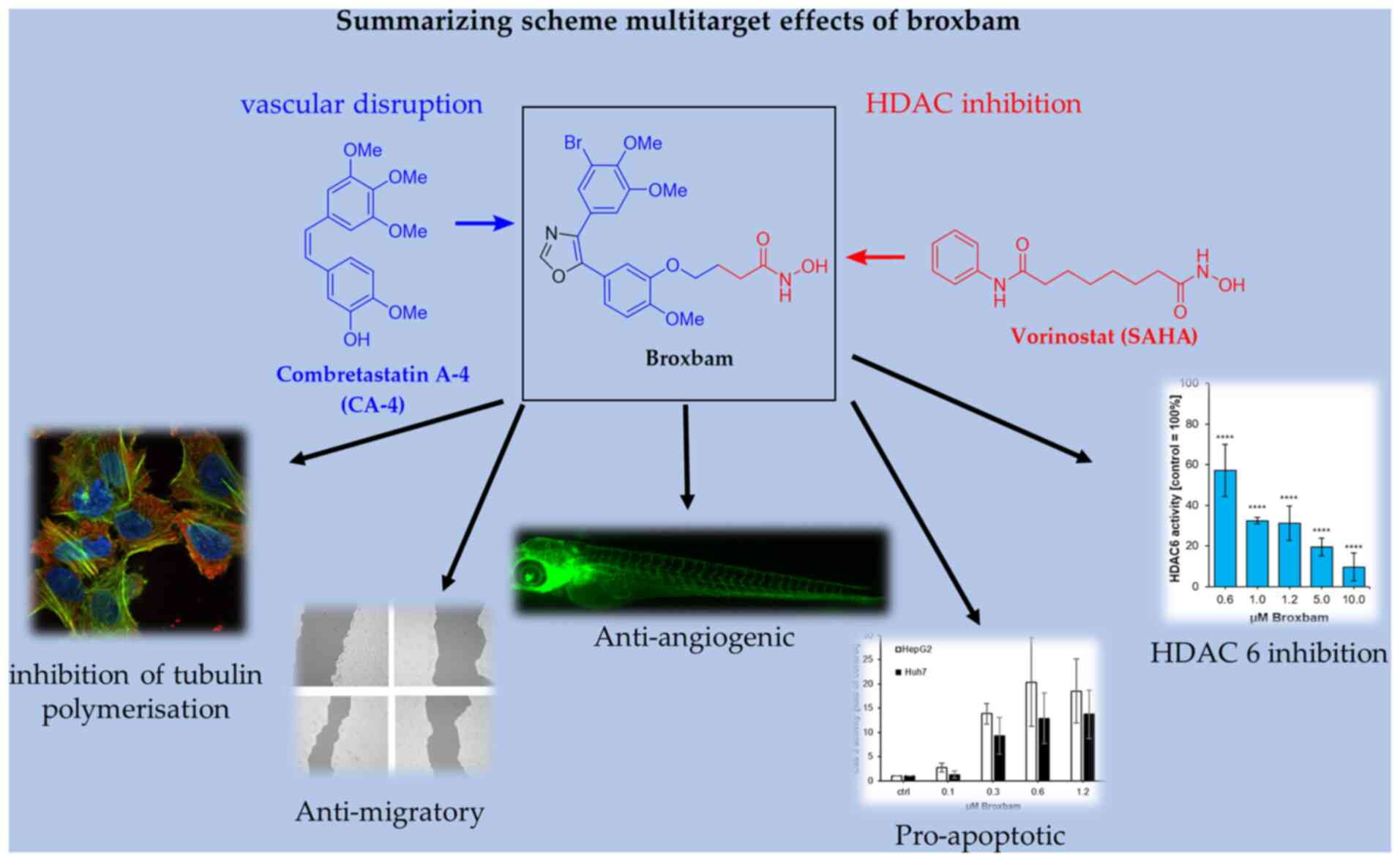Chimeric HDAC and the cytoskeleton inhibitor broxbam as a novel therapeutic strategy for liver cancer
- Authors:
- Published online on: April 28, 2022 https://doi.org/10.3892/ijo.2022.5363
- Article Number: 73
-
Copyright: © Bär et al. This is an open access article distributed under the terms of Creative Commons Attribution License.
Abstract
Introduction
The 5-year survival rate of patients with liver cancer (20%) is among the lowest compared with other types of cancer (1). Hepatocellular carcinoma (HCC) and cholangiocellular carcinoma (CCC) are two of the most important types of primary liver cancers, with HCC being the most common, which accounts for 70-90% of all types of liver cancer (2,3). By contrast, CCC accounts for ~10% of all liver malignancies (2,3). Although CCC is comparatively rare, they are highly aggressive and are typically characterised by poor 5-year survival rates, specifically 5-15% (2,3). The standard systemic therapeutic strategy for HCC is by using the multi-kinase inhibitor sorafenib, which remains unchanged over the last decade (4-7). However, adverse side effects, coupled with the increasing incidence of resistance, are posing significant therapeutic obstacles that needs to be overcome for the effective treatment of HCC (4-7). In addition, currently available treatment options for CCC are even more limited. At early stages surgical tumour resection is a curative option, but only palliative measures are available for advanced and metastatic CCC (8,9). Therefore, treatment possibilities remain limited, which induce severe side effects and only marginally increase the survival time (8,9). There is an urgent demand for novel treatment options for patients with advanced HCC or CCC.
One potential approach of tackling the therapeutic resistance and metabolic evasiveness of cancer cells is the development of 'chimeric inhibitors', which has been garnering interest over recent years (10,11). Using the advent of molecular hybridisation, two distinct drug pharmacophores can be merged into a single molecule, which can simultaneously attack different cellular and molecular targets (10,11). Due to their extensively researched structure-activity relationships, histone deacetylase inhibitors (HDACi) are at the centre of this chimeric drug approach. In recent years, chimeric agents featuring HDACi pharmacophores linked to either protein kinase inhibitors, modulators of the DNA structure or to moieties that can interfere with the cancer cell cytoskeleton, have been developed (11).
HDACs are amidohydrolases that serve a pivotal role in cellular chromatin remodelling (12). They have been previously implicated in the epigenetic regulation of cell metabolism, proliferation and differentiation of various solid cancers, such as urothelial, cervical, myeloma, ovarian and lung cancer, where they have already been tested in early-stage clinical trials (12,13). In several malignancies, including liver cancer, HDACs were found to be overexpressed, where their activity was also correspondingly enhanced (14). In turn, they stifle the expression of tumour suppressor genes, leading to uncontrolled cell division and insensitivity to cell repair mechanisms and suppression of apoptosis (14). Therefore, HDACi are regarded to be promising novel compounds for the therapy of a number of cancers, including liver cancer (14-16). In particular, vorinostat was the first HDACi to be clinically approved for the treatment of T-cell lymphoma (16-18).
Recently, combined treatment with the new HDACi resminostat and the established liver cancer drug sorafenib was reported to effectively counteract HCC growth and progression (19). Similarly, a synergistic inhibitory effect on the proliferation of HT-29 and HCT116 colon cancer cells has been reported for the combination of HDACi and microtubule disrupting agents (MDAs) (20). MDAs trigger the upregulation of p53 and enhance post-translational modifications on p53, such as phosphorylation and acetylation, in non-small lung cancer cells (21). In this regard, potentiation of apoptosis mediated by the combined treatment of the o-phenylenediamine-based HDACi MS-275 (entinostat) with the MDA taxol combretastatin (CA-4) was previously reported in MCF7 (breast cancer) and HCT (colon cancer) cell lines (22). Treatment with this drug combination led to a pronounced inhibition of tubulin polymerisation to impede neovascularisation and disrupt the tumour vasculature (23). These previous findings aforementioned therefore argue for the acceleration in the development of therapeutic agents that can simultaneously address ≥ one target. Drugs that can accomplish this by the means of several covalently-linked pharmacophores are called chimeric drugs (24). Recently, the chimeric inhibitor animacroxam, which induces both HDAC inhibition and cytoskeleton-interfering effects, has been shown to be particularly efficacious against testicular germ cell cancer (15).
Broxbam is a promising chimeric HDACi inhibitor. The pleiotropic effects of broxbam have been previously reported in the 518A2 melanoma cell line, where it was demonstrated to inhibit tubulin polymerisation and HDAC activity, disrupt the cytoskeleton and induce cell cycle arrest (20). Broxbam contains the structural hydroxamate motif of 1st generation HDACi that can also be found on vorinostat in addition to the trimethoxyphenyl motif commonly found on cytostatic MDAs, such as combretastatin A-4 (CA-4) (23,25). In particular, the oxazole bridge of the trimethoxyphenyl motif stabilizes the cis-configuration of the alkene (Fig. 1), which is essential for the attachment to the colchicine-binding site of tubulin heterodimers (26). It was recently shown that broxbam can exert antiproliferative effects in melanoma and colorectal cancer cell models (20). However, its potential suitability and efficacy against liver cancer remain poorly understood. Therefore, the present study aims to investigate the effects of broxbam on the physiology of liver cancer cells and the under-lying molecular mechanism of action using both in vivo and in vitro models.
Materials and methods
Compounds
Broxbam was synthesized according to literature (20). In brief, Van Leusen reaction of the 3-bromo-4,5-dimethoxyphenyl toluenesulfonylmethyl isocyanide reagent with ethyl 4-(1-methoxy-4-formyl-2-phenoxy) butyrate led to the ester-functionalised oxazole intermediate, which was reacted with hydroxylamine to form the target compound broxbam. Stock solutions (20 µM) of broxbam and vorinostat (cat. no. V-8477; LC Laboratories), were prepared in DMSO (Thermo Fisher Scientific, Inc.) stored at −20°C and diluted to the final concentration in fresh media before each experiment. In all experiments, the final DMSO concentration was <0.2%.
Cell culture
HepG2 (hepatoma; DSMZ no. ACC 180), Huh7 (hepatocellular carcinoma; RRID, CVCL_0336), TFK1 [cholangiocellular carcinoma; Deutsche Sammlung von Mikroorganismen und Zellkulturen (DMSZ) no. ACC 344] and EGI1 (cholangiocellular carcinoma; DSMZ no. ACC 385) cells, in addition to the non-transformed hepatocyte cell line non-transformed hepatocyte cell line AML12 (cat. no. CRL-2254) (27) were purchased from ATCC Company and stored for long time in liquid nitrogen in an in-house repository. Only cells in the early passages (<30 passages) were used for the study. The liver cancer cell lines are representative for the established hepatocellular carcinoma, hepatoblastoma and cholangiocarcinoma cell models for the in vitro research of liver cancer (28-32). The murine non-transformed hepatocyte cell line AML-12 (33,34) was used instead of a non-transformed human hepatocyte cell model, which was not available for the present study. However, AML-12 cells represent a widely applied non-transformed hepatocyte cell model (33,34).
The cells were maintained in RPMI 1640 medium containing 10% FBS and 100 U/ml penicillin and strepto-mycin (all from Gibco, Thermo Fisher Scientific, Inc.) and cultured at 37°C and 5% CO2 in a humidified atmosphere unless stated otherwise. Cell lines were serially passaged after trypsinisation, using 0.05% trypsin/0.02% EDTA solution (Bio & SELL GmbH). Only mycoplasma-free cultures were used and potential contamination was routinely monitored. Glucose and lactate levels from the cell culture supernatants were measured using a blood gas analyser (ABL800 Flex; Radiometer GmbH).
Small-interfering (si)RNA transfection
For the siRNA-mediated knockdown of HDAC6, Huh7 cells were seeded into six-well plates and cultured until they reached 40-50% confluency. Cells were then transfected with siRNAs (75 nM; ON-TARGET plus SMART pool human HDAC6, cat. no. L-003499-00-0010 or ON-TARGET plus non-targeting control pool, cat. no. D-001810-10-05; PerkinElmer, Inc.; https://horizondiscovery.com/en/gene-modulation/knockdown/sirna/products/on-target-plus-sirna-reagents?nodeid=entrezgene-10013&catalognumber=L-003499-00-0010) using the transfection reagent DharmaFECT1 (cat. no. T-2005-01) according to the protocol provided by Dharmacon; PerkinElmer, Inc. In the present study, SMART pool siRNAs targeting human HDAC6 and the non-targeting control containing a mixture of four oligonucleotides were used. The target sequences for human HDAC6 are as follows: Sequence (Seq) 1, 5′-GGG AGG UUC UUG UGA GAU C-3′; Seq2, 5′-GGA GGG UCC UUA UCG UAG A-3′; Seq3, 5′-GCA GUU AAA UGA AUU CCA U-3′ and Seq4, 5′-GUU CAC AGC CUA GAA UAU A-3′. Non-targeting control sequences are as follows: Seq1, 5′-UGG UUU ACA UGU CGA CUA A-3′; Seq2, 5′-UGG UUU ACA UGU UGU GUG A-3′; Seq3, 5′-UGG UUU ACA UGU UUU CUG A-3′ and Seq4, 5′-UGG UUU ACA UGU UUU CCU A-3′. After 48 h of transfection, cells were harvested and analysed by western blotting and reverse-transcription-quantitative PCR (RT-qPCR).
Crystal violet assay
Changes in cell numbers associated with drug treatment were monitored using crystal violet staining as previously described (35). In total, 1,500-3,000 cells/well were first seeded into 96-well plates and allow to detach for 72 h at 37°C, 5% CO2 and 95% humidity. The cells were then treated with either broxbam or vorinostat in the following concentrations: 0.1, 0.2, 0.4, 0.8, 1.6, 3.2, 6.4 and 10.0 µM for 24, 48 and 72 h at 37°C, 5% CO2 and 95% humidity, fixed with 1% glutaraldehyde for 30 min at room temperature and stained with 0.1% crystal violet (Sigma-Aldrich; Merck KGaA) for 30 min at room temperature. Water rinsing was then performed to remove any unbound dye, before 0.2% Trition-X100 was added to solubilise the bound crystal violet and the absorbance at 570 nm was measured using a microplate reader (Dynex Technologies). The light absorbance was assumed in linear proportion to the number of cells.
Real-time inhibition of cell proliferation
The measurement of cell proliferation in real-time was performed as previously described (15). Briefly, HepG2, Huh7 (1.0×104 cells/well), TFK1 (5×103 cells/well) and EGI1 (3×103 cells/well) cells were seeded into in eight-well E-plates (ACEA Biosciences, Inc.) and maintained under normal cell culture conditions for 24 h. After attachment of the cells, they were treated with concentrations of broxbam (0.1, 0.25, 0.5 and 1.0 µM) for ≤70 h at 37°C, 5% CO2 and 95% humidity. An impedance-based iCEL-Ligence system (RTCA Software Vs 2.1.0, ACEA Biosciences) was used to monitor the real-time proliferation of viable cells in the eight-well plates at 37°C, 5% CO2 and 95% humidity, every 15 min for 70 h. Cell proliferation was recorded as a unitless parameter called the 'cell index', which was defined as (Rtn-Rt0)/4.6 Ohm, with Rtn representing the measured resistance at time point n and Rt0 representing the background resistance measured at time point T0
Lactate dehydrogenase (LDH) cytotoxicity assay
Cells were seeded into 96-well microtiter plates at a density of 8×103 cells/well and treated with increasing concentrations (0.1, 0.3, 0.6, 1.5, 3.0 and 10.0 µM) of broxbam for 24 h at 37°C, 5% CO2 and 95% humidity. Cytoplasmic LDH release into the cell culture medium was measured using a colorimetric assay kit (cat. no. 11644793001; Sigma-Aldrich; Merck KGaA) according to the manufacturers' protocols (36).
Induction of chorioallantoic membrane (CAM) tumours
In total 2×106 HepG2 cells were resuspended in 10 µl RPMI medium containing 10% FBS and 100 U/ml penicillin and streptomycin (all from Gibco; Thermo Fisher Scientific, Inc.) and 10 µl Matrigel (BD Biosciences), before the cell suspension was applied into a silicone ring 5 mm in diameter onto the CAM of fertilised white Leghorn chicken eggs (Gallus domesticus) at day 8 of their embryonic development. Fertilized eggs were obtained from Valo Biomedia GmbH (Cuxhaven, Germany and the embryonic development was induced by incubating the eggs at 37.5°C and 80% humidity as described earlier (37). The tumourbearing chicken eggs were incubated for 24 h at 37.5°C to stimulate tumour formation, followed by the topical application of 20 µl PBS containing three concentrations of broxbam (1.2, 3.0 and 5.0 µM). After an incubation period of 72 h at 37.5°C and 80% humidity, the tumours were excised and carefully weighed to determine their mass.
Apoptosis detection
Measurement of caspase-3 activity
HepG2 and Huh7 cells were incubated (37°C, 5% CO2 and 95% humidity) for 48 h in RPMI growth medium (Gibco; Thermo Fisher Scientific, Inc.) containing the respective concentrations of test compounds (0.1, 0.3, 0.6 and 1.2 µM). The cells were rinsed twice with PBS. All cells were lysed with 500 µl lysis buffer (10 mM Tris-HCl, 10 mM NaH2PO4/Na2HPO4, 130 mM NaCl, 1% Triton X-100 and 10 mM NaPPi, pH 7.5) per 100 cells. Protein concentration was determined using a BCA protein assay kit (Pierce; Thermo Fisher Scientific, Inc.). The activity of caspase-3 was measured using the fluorogenic substrate AC-DEVD-AMC (cat. no. 14987; Caymen Chemical Company). In brief, the cell lysate was adjusted to a protein concentration of 500 mg/ml before 100 µl of this cell lysate were mixed with 100 µl substrate solution (20 µg/ml caspase-3 substrate AC-DEVD-AMC, 20 mM HEPES, 10% glycerol and 2 mM DTT, pH 7.5; Sigma-Merck; Merck KGaA). The samples were then incubated for 1 h at 37°C. The fluorescence of the substrate, cleaved by caspase-3, (excitation wavelength=380 nm, emission wavelength=460 nm) was measured using a Varioskan Flash fluorometer (Thermo Fisher Scientific, Inc.).
Detection of changes in the mitochondrial membrane potential (MMP HepG2 and Huh7 cells were seeded at a density of 8×103 cells/well in 96-well plates and maintained for 72 h at 37°C, 5% CO2 and 95% humidity until they were treated with 0.6 µM broxbam or 2.0 µM vorinostat for 3, 6 and 18 h at 37°C, 5% CO2 and 95% humidity. To measure MMP, cells were stained for 15 min in the dark at 37°C using the JC-1 dye (1 mg/ml; 5,5′,6,6′-tetrachloro-1,1′,3,3′-tetraethyl-benzimidazolylcarbocyanine iodide; Molecular Probes; Thermo Fisher Scientific, Inc.). The cells were analysed using a Varioscan Flash fluorometer (Thermo Fisher Scientific, Inc.) at excitation wavelengths of 485 nm and emission wavelengths of 535 nm. Signals in the orange region of the fluorescence can be detected when JC-1 aggregates occur because of a negative MMP, which indicates healthy mitochondria. In the event of a positive MMP, which results from mitochondrial damage, JC-1 occurs in its monomeric form giving rise to fluorescence in the green wavelength region (38). Accordingly, measurement of the ratio of orange to green fluorescence signal intensities allows the determination of changes in the MMP.
Western blotting
Whole cell extracts were prepared after harvesting substance-treated cells. HepG2 and Huh7 cells were incubated (37°C, 5% CO2 and 95% humidity) for 24 h in RPMI growth medium (Gibco; Thermo Fisher Scientific, Inc.) containing the respective concentrations of test compounds (BB: 0.6 and 1.2 µM; Vs, 4.0 µM). Lysis was performed by using lysis buffer (0.1% SDS, 0.5% sodium deoxycholic acid, 1% Nonidet P-40, 0.1 mM PMSF, 1 mg/ml aprotinin and 1 mg/ml pepstatin A1; all from Sigma Aldrich; Merck KGaA). Protein contents of samples were determined using a BCA protein assay kit and samples containing 30 µg protein subjected to 7.5% or 12% SDS-PAGE. Proteins were then transferred onto PVDF membranes by electroblotting for 1.5 h. Membranes were blocked for 1 h using 5% skimmed milk powder solution followed by incubation at 4°C overnight with primary antibodies. The following antibodies were used: Glucose transporter (GLUT) 2 (1:1,000; cat. no. 071402 MilliporeSigma), p53 and phosphorylated (p-) p53 (1:1,000; cat. nos. 9282 and 9286, respectively; Cell Signalling Technology, Inc.), HDAC1, HDAC2, HDAC4 and HDAC6 (1:1,000; cat. nos. 5356, 5113, 7628 and 7558, respectively; Cell Signalling Technology, Inc.). Detection of tubulin (anti-Tubb2B, cat. no. TA337744; Origene Technologies, Inc.) served as a loading control. Membranes were washed with 0.1% Tween in PBS and incubated with HRP-coupled anti-IgG antibody (1:10,000; cat. nos. NA934 and NA931, Amersham; Cytiva) for 1 h at room temperature. Protein signals were visualised using enhanced chemiluminescent detection kit (Amersham; Cytiva) and a Fusion SL camera (Vilber Lourmat Deutschland GmbH). For quantification, ImageJ (Vs 1.53j, National Institutes of Health) was used and the density of the protein bands was normalised to tubulin as a loading control.
RT-qPCR
Cellular RNA of untreated HepG2 and Huh7 cells were extracted using GeneMATRIX Universal RNA Purification Kit (Roboklon GmbH) according to the manufacturers' protocols, followed by treatment with 1 U DNAse I (Gibco; Thermo Fisher Scientific, Inc.) per µg RNA for the elimination of possible DNA contaminations. Reverse transcription into cDNA and qPCR were performed using GoTaq® 1-Step RT-qPCR System (Promega Corporation) on a QuantStudio 5 Real-Time PCR System (Thermo Fisher Scientific, Inc.). The mixture for each sample/primer mix had a final volume of 10 µl containing 20 ng RNA and 250 nM of each primer. Melt curve controls were run to ensure primer specificity. The parameters for reverse transcription were as follows: 37°C for 15 min, 95°C for 10 min. Primer sequences are listed in Table SI. The obtained cDNA was analysed by using GoTaq® 1-Step RT-qPCR System (Promega Corporation) and qPCR was run on a StepOne-Cycler (Thermo Fisher Scientific, Inc.) for 40 cycles of amplification (initial denaturation for 5 min at 95°C; followed by denaturation at 95°C for 15 sec, annealing at 60°C for 20 sec, elongation at 72°C for 45 sec for 40 cycles). All samples were run in tripli-cate. The relative target gene expression was calculated using the 2−ΔΔCq method using GAPDH, β-actin or 18S rRNA as an internal control (39).
Inhibition of HDAC activity
The ability of broxbam to inhibit HDAC1, -2, -4 and was measured using a cell free fluorogenic HDAC Assay (cat. nos. 50061, 50062, 50064, 50076 BPS Bioscience, Inc.). The HDAC activity was measured according to the protocols of the manufacturer. Briefly, purified human recombinant HDAC enzymes contained with the assay kit and fluorogenic HDAC substrates were used to measure HDAC activity. In total, 50 µl assay buffer containing 1 µg/µl BSA, the human recombinant HDAC enzyme, the test compound and the corresponding HDAC substrate was added into a black 96-well assay plate. The reaction in each well was incubated at 37°C for 30 min, followed by the addition of 50 µl HDAC developer reagent and incubation at room temperature for 15 min. Fluorescence intensity was measured using a Varioskan Flash Fluorometer (Thermo Fisher Scientific, Inc.) using an excitation wavelength of 380 nm and an emission wavelength of 460 nm.
Immunofluorescence staining of the cytoskeleton
HepG2 cells were seeded onto glass coverslips at a density of 1×105 and were allowed to attach and proliferate for 24 h (37°C, 5% CO2 and 95% humidity). Cells were treated with broxbam (0.6 µM) and vorinostat (4 µM) whereas a corresponding volume of DMSO was used as a negative control. Treated cells were incubated for additional 24 h (37°C, 5% CO2 and 95% humidity) and fixed with 4% formaldehyde in PBS for 20 min at room temperature. The samples were then blocked and permeabilised (1% BSA and 0.1% Triton X-100 in PBS) for 30 min at room temperature. For the immunostaining of the microtubule structures, the cells were incubated for 1 h at 37°C in the dark with mouse primary anti-human α-tubulin monoclonal antibody (1:500; cat. no. T6199; Sigma Aldrich; Merck KGaA), followed by treatment with a AlexaFluor®-conjugated 546 goat anti-mouse secondary antibody (1:500; cat. no A-21133; Thermo Fisher Scientific, Inc.) for 1 h at room temperature in the dark. Cellular actin filaments were stained for 1 h at 37°C in the dark using phalloidin (1:1,000, cat. No A12379 AlexaFluor®-conjugated 488; Invitrogen; Thermo Fisher Scientific, Inc.). Coverslips were mounted in DAPI containing Mowiol (Mowiol 4-88; 1 µg/ml DAPI; Carl Roth GmbH) for additional nuclei counterstaining. Fluorescence microscopic imaging (magnification, ×60; Spinning Disk Confocal microscope; Nikon Corporation) was performed at the Charité Advanced Medical BioImaging Core Facility (Berlin, Germany).
Scratch wound healing assay
HepG2 cells were allowed to proliferate to confluence in six-well plates. Using a 10 µl pipette tip, the cell monolayer was scratched once horizontally and vertically. Wells were rinsed with PBS and fresh medium was added, containing two concentrations of broxbam (0.6 and 1.2 µM), whereas a corresponding volume of DMSO was used for a control. The cell monolayers were incubated for 24 h (37°C, 5% CO2 and 95% humidity), followed by photographic documentation using a digital camera (Kappa Optronics GmbH). Migration of cells was quantified using the TScratch software (version 1.0; CSElab). Migration values were normalised to control, which was set as 100%. The experiments were performed under normal FBS conditions (10%), since HepG2 cells could not tolerate serum deprivation and reacted with immediate and pronounced cell detachment. In addition, serum deprivation is a procedure that is preferable necessary for long-term observations (>24-48 h), where cell proliferation instead of migration becomes the predominant factor for wound healing (40,41).
Zebrafish angiogenesis assay
To examine the angiogenesis in vivo, experiments with zebrafish embryos were performed, which represents a viable model for the evaluation of angiogenic effects of small molecules (42). In the developing zebrafish embryo, the sub-intestinal veins (SIVs) represent a characteristic blood vessel system that can be easily visualised (42). Eggs from the transgenic Tg(fli1:EGFP)y1 mutant Casper zebrafish stem were obtained 2-5 h after egg deposition connected to spawning process from the animal breeding facility of the University of Bayreuth, which has the permission to keep and breed vertebrates and cephalopods for experimental purposes according to § 11 German animal Welfare Law (permission no. OBK/A 2; Bayreuth, Germany). Zebrafish are kept at 20-26°C in water pH 6.0-8.0 under standard atmosphere.
After the egg deposition, the spawn fish eggs (1 day post fertilisation) were collected, rinsed, and transferred into a petri dish filled with E3-medium (5 mM NaCl, 0.17 mM KCl, 0.33 mM CaCl2, 0.33 mM MgSO4 and 0.01% methylene blue in ddH2O; pH 7.2) and incubated for 24 h at 28°C. Healthy embryos were then dechorionated, which means the removal of the egg shell, and five embryos per well were transferred into six-well plates in 5 ml E3-medium. In total, 100-fold pre-dilutions of test compounds (final concentrations were 1 µM, 750 and 500 nM) in ddH2O were prepared and added to the E3-medium at 50.5 µl per well, followed by incubation for 48 h at 28°C. After the addition of 50 µl 0.04% tricaine solution (ethyl-3-aminobenzoate-methanesulfonate; Sigma Aldrich; Merck KGaA) to the E3-medium in the six-well plates, the embryos (3 days post fertilisation) were anaesthetised (5 min at room temperature) to a final tricaine concentration of 0.0004% before the blood vessel system was visualised and documented by fluorescence microscopy with up to two-fold magnification (excitation wavelength, 488 nm; emission wavelength, 510 nm; Leica MZ10F fluorescence microscope; Leica Microsystems GmbH; AxioCam l cm; Carl Zeiss AG). The area of SIVs was measured using Image J version 1.52a. At the end of the experiments, 1 ml anaesthetic tricaine (tricaine mesylate; 5 g/l) was added to 5 ml E3-media to kill the zebrafish larvae (3 days post fertilisation) with an overdose of the anaesthetic, at a final concentration of 833 mg/l.
Statistical analysis
Statistical analysis of the data was performed using GraphPad Prism 8 software for Windows (GraphPad Software, Inc.). If not indicated otherwise, data were presented as the mean ± standard error of the mean. Unpaired Student's t-tests were used for two-group comparisons. To test for statistical significance between > two groups, one-way ANOVA coupled with Tukey's post hoc tests was used. P<0.05 were considered to indicate a statistically significant difference. All experiments were performed in triplicate unless otherwise stated. The exact number of independent repetitions for each assay is provided in the figure legends.
Results
Inhibition of cell proliferation and cytotoxicity
It was previously reported that broxbam exerts selective anti-tumour effects at half maximal inhibitory concentrations (IC50) in the low µM to two-digit nM range (20). In the present study, the potential effects of broxbam in liver cancer cell models were evaluated. Table I summarises the IC50 values calculated for broxbam and vorinostat in liver cancer cell lines HCC and CCC and non-transformed hepatocytes. Notably, broxbam exhibited higher antiproliferative potency in all liver cancer cell lines compared with non-transformed hepatocytes, which required three-times higher IC50 concentrations (Table I). This suggests the selectivity of broxbam towards liver cancer cells. In addition, broxbam exerted higher antiproliferative capabilities compared with the clinically relevant HDACi vorinostat in all liver cancer cell models test. Unlike broxbam, vorinostat did not appear to display cancer specificity, since its IC50 values did not differ between the liver cancer cell lines and the non-transformed AML-12 cells (Table I).
Table IGrowth inhibitory concentrations (IC50) of compounds applied to liver cancer cell lines HepG2 and Huh7, CCC cell lines TFK-1 and EGI-1 and mouse hepatocytes (AML12)a. |
Using the iCELLigence real-time cell viability and proliferation analysis system, the kinetic profile and onset of the inhibition of proliferation mediated by broxbam were deter-mined. In case of the HepG2 and Huh7 cell lines, a distinct reduction in cell proliferation was observed at as early as 12 h after the application of broxbam in a dose-dependent manner (Fig. 2A and B). In CCC cell lines, this dose-dependent inhibitory effect was also detected, but instead becoming more pronounced 24 h after treatment (Fig. 2C and D). To exclude the contribution of unspecific cytotoxicity to these antiproliferative effects exerted by broxbam, the release of lactate dehydrogenase (LDH) from the cytosol into the cell culture supernatant of HepG2, Huh7 and AML12 cells was measured (Fig. 3). Increased LDH release would indicate the presence of nonspecific and necrotic cell death due to treatment-induced damage of cell membranes (36). However, treatment of HepG2 or Huh7 cells with rising concentrations of broxbam (0.1-10 µM) did not lead to significant increases in LDH release after 24 h (Fig. 3). The same effects were also observed in non-transformed hepatocytes (AML12) after broxbam treatment (Fig. 3). This suggests that broxbam does not compromise cell membrane integrity and that it exerted no immediate cytotoxic effects even at concentrations as high as 10 µM.
In vivo tumour growth reduction
The potential antineo-plastic effects of broxbam in liver cancer tumours was next tested using in vivo chick embryo experiments, specifically by applying the modified chorioallantoic membrane (CAM) assay. HepG2-derived microtumours from an initial volume of 20 µl were grown on the CAM of fertilised chicken eggs for 24 h. Subsequently, the microtumours were treated for 72 h with either PBS (control) or rising concentrations of broxbam (1.2-5.0 µM). At the end of the experiment, tumour masses were excised and weighed. Compared to PBS-treated controls, broxbam (3 and 5 µM) induced a significant reduction in liver cancer microtumour growth (Fig. 4).
To further characterise the underlying signalling and metabolic events underlying these antitumor effects of broxbam observed in the present study, its potential effects on glucose metabolism were next assessed. Cancer cells preferentially use glycolysis to consume glucose as the substrate for energy metabolism, in a process known as the Warburg effect (43). Therefore, the impact of broxbam on the expression of GLUT2, which is crucial for hepatic glucose uptake (44), was investigated. In addition, the glycolytic activity of HepG2 and Huh7 cells was also assessed by measuring the consumption of glucose, production of lactate and its release into the supernatant of the cell culture medium. Protein expression levels of GLUT2 were not affected by broxbam, though the HDACi vorinostat markedly reduced the expression of GLUT2 compared to broxbam treated group in both HepG2 and Huh7 cells (Fig. S1). This finding suggests that vorinostat, but not broxbam, can inhibit cellular glucose uptake by downregulating GLUT2 expression. By contrast, the glycolytic activity of broxbam-treated liver cancer cells was found to be decreased significantly. Compared with that in the untreated controls, the remaining glucose in the cell culture supernatant of broxbam-treated HepG2 cells was markedly higher whereas the production and release of lactate was decreased (Fig. S1). This lower glucose consumption and reduced lactate production indicate reduced glycolytic activity in broxbam-treated cells. In addition, no such reduction in glycolytic activity could be observed in HepG2 cells following vorinostat treatment, suggesting no effects were mediated by vorinostat on glucose uptake or lactate production and release.
Proapoptotic mode of action
To further elucidate the mechanisms by which broxbam exerted antitumour effects on the liver cancer cells the extent of apoptosis induction was next measured. Apoptosis induction considered to be one of the primary objectives of targeted cancer therapy since it results in the specific and inflammation-free elimination of cancer cells. Apoptosis induction occurs through two distinct mechanisms, either by the activation of cellular death receptors or through the mitochondria-driven activation of caspase-3 (45). Broxbam was found to induce mitochondria-driven apoptosis in liver cancer cells, as evidenced by fluorometric changes in the MMP of broxbam treated cells (Fig. 5A). An increase in the green/red ratio indicates a reduction in the MMP and therefore mitochondrial damage, which may have served as a trigger for the activation of the apoptosis-associated tumour suppressor protein p53. A significant increase in the green/red ratio following treatment with the IC50 concentration of broxbam at 0.6 µM was observed after 3 and 6 h (Fig. 5A).
By contrast, treatment with vorinostat at its IC50 concentration of 2 µM, did not lead to an apoptosis-indicating increase in the green/red ratio. Instead, a significant reduction was observed, suggesting that vorinostat was not likely to induce mitochondria-driven apoptosis (Fig. 5A).
In following experiments broxbam treatment was shown to induce a dose-dependent increase in the phosphorylation of p53 of HepG2 and Huh7 cells (Fig. 5C-H), consistent with the aforementioned data on the broxbam-induced changes in MMP for the initiation of mitochondria-driven apoptosis (Fig. 5A). In addition, no increase in p53 phosphorylation in HepG2 (Fig. 5D) or Huh7 (Fig. 5G) cells could be observed after vorinostat treatment, which is in accordance with the failure of vorinostat to decrease the MMP (Fig. 5A).
Mitochondria serve a pivotal role in the regulation of apoptotic caspase activation. The caspase cascade lies down-stream of the loss of MMP and activation of p53 (46-48). This cascade eventually leads to the activation of the executioner caspase-3 (49). Therefore, Caspase-3 activity was next assessed using a fluorogenic caspase-3 assay, which functions by the specific recognition of the enzymatic activity of phosphorylated caspase-3 (15). After broxbam treatment, HepG2 and Huh7 cells exhibited a dose-dependent increase in apoptotic caspase-3 activity compared with that in the control group (Fig. 5B). Of note, maximal capsase-3 activity could already be observed at the concentration of 0.6 µM broxbam (Fig. 5B), which corresponded to the IC50 values of broxbam in these cells (Table I).
HDAC expression and activity
To clarify if HDAC inhibition forms part of the antitumour mechanism of broxbam, its effects on HDAC expression and activity were investigated. RT-qPCR was used to measure the expression levels of the 11 subtypes of HDACs (HDACs 1-11) in the HepG2 and Huh7 cells. Although the mRNA expression levels of HDAC1 and HDAC2 were considerably lower compared with those of the other HDAC subtypes, all 11 HDACs tested were found to be expressed in both cell lines (Fig. 6).
Subsequently, the potential treatment-induced changes in the protein expression levels of HDAC1, -2, -4 and -6 were assessed by western blotting and densitometric analysis. HDAC1 and HDAC2 belongs to class I HDACs and are local-ized in the nucleus of the cell (50). HDAC4 and HDAC6 are class II HDACs and both can be found in the cytoplasm as well as in the nucleus of a cell (50). These HDACs were previously found to be overexpressed in human pancreatic adenocarcinoma and hepatocellular carcinoma (50,51). Exposure of HepG2 and Huh7 cells to 0.6 µM and 1.2 µM broxbam, concentrations corresponding to their respective IC50 and two-fold IC50 values, did not lead to significant changes in any of the HDAC subtypes (Fig. 7). An exception was the significant increase in HDAC4 expression in Huh7 cells treated with 1.2 µM broxbam compared with that in the control group (Fig. 7C). This finding suggests that broxbam functions as an inhibitor of HDAC activity instead of being a regulator of HDAC expression (Fig. 7).
The activities of HDACs -1, -2, -4 and -6 following treatment with IC50 and two-fold IC50 concentrations of broxbam and vorinostat were assessed using a cell-free enzymatic assay system. HDAC subtype-specific inhibition of the cleavage of fluorogenic peptide substrates (Fig. 8A) was next detected and compared with the untreated control group, which was set to 100%. Broxbam exerted an attenuating effect on the activity of HDAC1 and -6, but did not affect the activities of HDACs -2 and -4. Vorinostat mediated potent inhibitory effects on the HDACs -1 and -2, which exceeded that of broxbam. Therefore, broxbam and vorinostat inhibited the individual HDAC isoforms with distinct profiles. However, both compounds were concluded inhibit HDAC1, with broxbam showing specificity towards HDAC6 whereas vorinostat showed specificity towards HDAC2. Due to this potent inhibitory effect of broxbam against HDAC6, the present study next examined its potential dose dependency over the concentration range from 0.6 to 10 µM, which revealed 90% inhibition of HDAC6 activity at 10 µM, the highest broxbam concentration tested (Fig. 8B).
To investigate the contribution of HDAC6 inhibition towards the antiproliferative effects of broxbam in liver cancer cells (Fig. 2), HDAC6 knockdown was performed using siRNA. After 48 h of transfection with HDAC6-specific siRNA, the expression of HDAC6 protein in Huh7 cells was significantly decreased compared with that in cells transfected with the si-mock (Fig. 8C and D). Furthermore, the expression of typical markers of cell proliferation Ki-67 and E2F3 (52,53), were also found to be decreased significantly compared with that in cells transfected with the si-mock (Fig. 8E and F) suggesting a distinct contribution of HDAC6 inhibition towards the antiproliferative (Figs. 1 and 2) and antineoplastic (Fig. 4) effects of broxbam in liver cancer.
Dynamics of the cytoskeleton and cellular migration
Since broxbam contains the trimethoxystilbene motif of the vascular disrupting natural product CA-4 within its structure (23,25,26), it was next examined for its possible effects on the tubulin cytoskeleton and associated processes. Its inhibitory effects on the polymerisation of purified tubulin in vitro have already been previously reported (20). As HDAC6 has been found to function as a tubulin deacetylase to interfere with microtubule-dependent cell motility (54), the effects of broxbam on the microtubule and F-actin cytoskeleton of HepG2 cells were investigated using immunofluorescence staining. The formation of F-actin stress fibres and focal adhesions was observed following treatment with broxbam at its IC50 concentration (Fig. 9). Furthermore, the microtubule cytoskeleton appeared to be markedly altered compared with that in the control group. In general, broxbam-treated cells were considerably enlarged, especially their nuclei (Fig. 9). These effects were more prominent compared with those mediated by vorinostat, even after treatment with vorinostat at a concentration of two-fold IC50 (Fig. 9).
Cytoskeletal components, such as microtubules and actin fibres, are critical for cell migration (55,56). To investigate the effect of broxbam on cell migration, a scratch wound healing assay was performed. An observation period of 24 h was chosen to minimise the possibility of the migratory process being distorted by cell proliferation. The average doubling time of HepG2 cells is ~48 h, suggesting that HepG2 cell proliferation is unlikely to contribute significantly to wound closing (57). Broxbam treatment led to a significant reduction in gap closing by the HepG2 cell monolayer compared with that in the untreated control group (Fig. 10). In addition, broxbam exerted a potent antimigratory effect even when applied at its IC50 concentration of 0.6 µM (Fig. 10B).
Antiangiogenic effects in vivo
A previous study validated the properties of the two structural motifs on broxbam, which are HDAC-inhibition mediated by the hydroxamic acid pharmacophore and interference with cytoskeletal dynamics by its trimethoxystilbene motif (20). There is a possibility that inhibition of tubulin polymerisation and HDAC activity by broxbam may also translate into an antiangiogenic effect. Due to the previously known antiangiogenic effects of CA-4 (23) and the well-established association between HDACs as modulators of hypoxia-induced factor-1α and vascular endothelial growth factor (VEGF) expression (58), it was hypothesised that broxbam may also exert antiangiogenic properties. Therefore, in vivo zebrafish angiogenesis assays were performed (42). Broxbam mediated a dose-dependent antiangiogenic effect in reducing the area of the sub-intestinal veins (SIV) in developing zebrafish embryos, which became visible at concentrations equating to its IC50 value (Figs. 11 and 12). Signs of cardiotoxicity, such as dilation of the pericardial sac, which is a known unwanted side effect of antiangiogenic substances, such as CA-4 (59), could not be observed (Figs. 11 and 12).
Discussion
Broxbam was recently reported to be a potent anticancer agent against various non-liver cancer cell models (20). In the present study, it was shown to exert antiproliferative properties in HCC and CCC liver cancer cell models. This novel chimeric compound, which consists of a HDAC-inhibitory hydroxamic acid pharmacophore and a cytoskeleton-interfering trimethoxystilbene motif, inhibited the proliferation of liver cancer cells at near-nanomolar concentrations (IC50, ~0.6 µM). This exceeded the antiproliferative potency of the clinically established HDACi vorinostat (IC50, 1.4-3.2 µM). Unlike vorinostat, broxbam exerted preferential specificity for cancer cells over non-transformed murine hepatocytes. Real-time kinetic investigation of the antiproliferative effects of broxbam revealed an early onset of this effect, at 12-24 h, after drug application. The prohibitive effects of broxbam on liver cancer cells was found not likely to be due to unspecific cytotoxicity, but instead likely to be due to the targeted and orchestrated modulation of cancer cell-specific signalling pathways. This in turn lead to antiproliferative, anti-angiogenic, anti-migratory and apoptotic effects, in addition to the breakdown of cellular energy metabolism. The decrease in the glycolytic activity of liver cancer cells after broxbam treatment may be of therapeutic importance in terms of the glucose addiction of cancer cells, which is required for the maintenance of metabolism (the Warburg effect) (43).
Broxbam was found to induce the apoptosis of liver cancer cells through the mitochondrial-driven apoptosis pathway. A protein of importance for mitochondrial apoptosis is the p53 tumour suppressor protein, the phosphorylation of which is associated with the disruption of mitochondrial function and subsequent cell death (48). Phosphorylation of p53 induces the expression of p53 regulated apoptosis inducing protein 1, which is localised in the mitochondria and leads to the disruption of MMP en route to triggering apoptosis (60,61). Consistent with this mechanism, the present study found that broxbam induced p53 phosphorylation, reduced MMP and subsequently activated the apoptosis-specific effector caspase-3. The activation of caspase-3 directly contributes to core apoptotic processes, such as the dismantling of cell components and formation of apoptotic bodies therefore, it represents a direct marker for the activation of apoptosis (62). The extent of apoptosis mediated by broxbam was studied in the present study in two liver cancer cell lines with distinct p53 statuses. HepG2 cells represents a p53-wild-type cell line whereas Huh7 cells harbour a mutated codon in the p53 gene leading to the overexpression of the functionally-repressed p53 (63). Caspase-3 activation by broxbam was more pronounced in the p53-native HepG2 cells compared with that in the p53-mutated Huh7 cells. However, broxbam promoted p53 phosphorylation in both cell models without altering the expression of the total p53 protein. By contrast, vorinostat did not alter p53 phosphorylation in either of the cell models, whilst significantly downregulating p53 expression in Huh7 cells. It is tempting to speculate that this may be the result of differences in the HDAC subtype specificity between broxbam and vorinostat, especially in their inhibitory activities towards HDAC6 activity. However, further research is required to clarify this putative association. It is noteworthy that broxbam can induce p53 phosphorylation both in cells with wild-type and mutant p53, whilst vorinostat could not induce p53 phosphorylation.
Evaluation of the effects of broxbam and vorinostat on HDAC revealed that neither of the compounds significantly influenced the protein expression of the HDAC subtypes -1, -2, -4 and -6, instead inhibiting their HDAC enzyme activity. Subtype-specific profiling revealed pronounced differences in the ability of broxbam and vorinostat to inhibit HDAC6. Whilst broxbam potently inhibited HDAC6 activity (>90%) at a concentration of 10 µM, vorinostat could only mediate a comparatively weak inhibition of 20%.
HDAC6 is a unique member of the HDAC family not only for its role in histone acetylation and deacetylation, but also in targeting several non-histone substrates, such as cortactin and heat shock protein 90, thereby regulating cell proliferation, metastasis, invasion, and mitosis in tumours of SKOV3 human ovarian cancer cells (64). Accordingly, it has been previously demonstrated that HDAC6 inhibition can lead to the inhibition of cell proliferation, apoptosis, reduction in migration and motility of fibroblasts, SKOV3 ovarian cancer, SKBR3 breast carcinoma, and MCF7 breast cancer cell lines (65). This is consistent with observations in the present study with regards to the broxbam-mediated HDAC6 inhibition of liver cancer cells. HDAC6-specific siRNA silencing in Huh7 cells, which mimicked the effects of HDAC6 inhibition exerted by broxbam, led to a significant downregulation of proliferation markers Ki67 and E2F3. α-Tubulin is another non-histone substrate that can be deacetylated by HDAC6 (54,56,66). HDAC6-dependent deacetylation of tubulin has been reported to result in potent effects on cytoskeletal dynamics and cell migration (54,66,67). HDAC6 has also been previously associated with the function of microtubule dynamics and regulation of microtubule-dependent cell migration (54). In the present study, broxbam-treated liver cancer cells displayed profound alterations in their cytoskeleton components F-actin and microtubules. After microtubules become disrupted, f-actin stress fibres and focal adhesions are formed in response (68,69). The cytoskeletal effects of broxbam exceeded those mediated by vorinostat, which corresponded with the weaker inhibitory effects of vorinostat on HDAC6 activity.
Broxbam was also found to exert antiangiogenic effects in vivo, as shown by the suppression of SIV growth in the zebrafish embryos. This effect was visible already at nM concentrations, resembling the antiproliferative IC50 values of broxbam in liver cancer cells. Notably, the antiangiogenic effects of broxbam were not accompanied by signs of cardiotoxicity or impairments in the development of zebrafish embryos, which are known to be highly sensitive to toxic stress (70). The antiangiogenic effects of broxbam were likely to be due to a combination of mechanisms, with contributions from both pharmacophores contained within the structure of this chimeric compound. In this respect, HDACis are known to inhibit VEGF-induced angiogenesis in vitro as well as in vivo (71), such that CA-4-driven anti-angiogenesis has also been linked to the inhibition of VEGF (72). However, tumour vasculature disrupting agents, especially those derived from CA4, have been shown to confer a high toxicity risk (59). Therefore, although broxbam contains a CA4-derived pharmacophore, it did not mediate toxic effects. This suggests that the effects of this novel chimeric compound may instead arise from its inhibitory effects on HDACs. The present study revealed that HDAC6-specific knockdown resulted in the downregulation of E2F3 expression in Huh7 cells. E2F3 is regarded to be a key factor for endothelial cell proliferation and angiogenesis (73). Therefore, it is conceivable that the pronounced HDAC6 inhibition of broxbam substantially contributed to its antiangiogenic effects due to the suppression of endothelial E2F3 expression. Further study is warranted to verify this hypothesis. The effects of broxbam on liver cancer cells revealed in the present study are summarized in Fig. 13.
Currently available treatment options for advanced and inoperable liver cancer are restricted to multi-kinase inhibitors, such as sorafenib or regorafenib (74). Although the therapeutic concentration of sorafenib is ~8 µM (75), lower concentrations of broxbam was able to induce pronounced antitumor effects in the in vivo experiments with liver cancer xenografts on the CAM of fertilised chicken eggs. In addition to the therapeutic effects mediated by this low dosage of broxbam, which prob-ably does not induce pronounced side effects, it also exhibited pronounced antineoplastic effects. This renders broxbam to be the experimental compound for alternative approaches for clinical liver cancer treatment.
The combination of HDACis and sorafenib has previously been demonstrated to exert enhanced anticancer activity and may therefore be an advantageous approach compared with sorafenib monotherapy (51,76,77). Freese et al previously reported that HDACi sensitised HCC cells to sorafenib treatment (78), which may be due to the overexpression of HDACs in HCCs. In a recent review, Garmpis et al (51) highlighted the potential suitability of HDACis as anticancer agents and their application in combinatorial therapies for the enhanced treatment of HCC. Although the preclinical data of HDACi-based combination therapies are promising, these authors also reported results from a critical phase 1 clinical trial in which sorafenib was tested in combination with vorinostat in patients with liver cancer. Although some patients showed good tolerability and stable disease, this treatment also led to adverse toxicities in the majority of patients, which necessitated dose modifications and prevented progression towards phase 2 clinical trial (79). In the present study, results from the preclinical in vitro and in vivo studies suggest the suitability and tolerability of this chimeric hydroxamate-trimethoxystilbene conjugate for liver cancer treatment. The fact that signs of toxicity were observed in neither zebrafish embryos nor in the CAM, couple with the findings that the chicken embryos developed and survived, suggest that broxbam may exert fewer toxic effects compared with other HDACis, including vorinostat. Future studies involving the effects of combination therapies with broxbam and sorafenib should clarify this important issue. In addition, to address the suitability of broxbam for personalised therapeutic approaches, investigation of patient-derived primary liver cancer cells should be executed.
To conclude, the present study evaluated the recently-introduced chimeric inhibitor broxbam (20) for its potential anticancer activity in liver cancer cells and the underlying molecular mechanism. Additionally, its possible antitumoral and antiangiogenic effects were examined in in vivo settings by performing in chick embryo and zebrafish experiments. On the basis of the presented data, broxbam is implicated to be a promising chimeric HDACi that should be evaluated further as a potential compound for liver cancer treatment, either as a monotherapy or in combination with other clinically-relevant HCC therapeutics, such as sorafenib.
Supplementary Data
Availability of data and materials
The datasets used and/or analysed during the current study are available from the corresponding author on reasonable request.
Authors' contributions
SIB: Investigation, zebrafish angiogenesis assay and data analysis. AD: Investigation, crystal violet assay, real-time inhibition of cell proliferation, lactate dehydrogenase (LDH) cytotoxicity assay, western blotting, reverse transcription-quantitative PCR (RT-qPCR), apoptosis detection, HDAC activity assay, immunofluorescence assay and scratch wound healing assay. GTA: Investigation, small-interfering (si)RNA assay, western blotting and RT-qPCR. MF: Western blotting and RT-qPCR. AK: Investigation, crystal violet staining and LDH-Assay. LK: Investigation, crystal violet staining and LDH-Assay. BB: Conceptualisation, proof reading, validation. RS: Conceptualisation, validation and language proof reading. BN: Conceptualisation and CAM Assay. MH: Conceptualisation and validation and proof reading. All authors have read and agreed to the published version of the manuscript. SIB, BN, MF and AK confirm the authenticity of all the raw data.
Ethics approval and consent to participate
Not applicable.
Patient consent for publication
Not applicable.
Competing interests
The authors declare that they have no competing interests.
Acknowledgments
Not applicable.
Funding
The present study was funded by the Else Kröner-Fresenius-Stiftung Grant No. 2016 A47 (to AD).
Abbreviations:
|
CA-4 |
combretastatin A-4 |
|
CAM |
chorioallantoic membrane |
|
CCC |
cholangiocellular carcinoma |
|
GLUT2 |
glucose transporter 2 |
|
HCC |
hepatocellular carcinoma |
|
HDAC |
histone deacetylase |
|
HDACi |
histone deacetylase inhibitor |
|
IC50 |
mean inhibitory concentration |
|
LDH |
lactate dehydrogenase |
|
MMP |
mitochondrial membrane potential |
|
SIV |
subintestinal veins |
References
|
Siegel RL, Miller KD, Fuchs HE and Jemal A: Cancer statistics, 2021. CA Cancer J Clin. 71:7–33. 2021. View Article : Google Scholar : PubMed/NCBI | |
|
Mosconi S, Beretta GD, Labianca R, Zampino MG, Gatta G and Heinemann V: Cholangiocarcinoma. Crit Rev Oncol Hematol. 69:259–270. 2009. View Article : Google Scholar | |
|
Bray F, Ferlay J, Soerjomataram I, Siegel RL, Torre LA and Jemal A: Global cancer statistics 2018: GLOBOCAN estimates of incidence and mortality worldwide for 36 cancers in 185 countries. CA Cancer J Clin. 68:394–424. 2018. View Article : Google Scholar : PubMed/NCBI | |
|
Vogel A, Cervantes A, Chau I, Daniele B, Llovet JM, Meyer T, Nault JC, Neumann U, Ricke J, Sangro B, et al: Hepatocellular carcinoma: ESMO clinical practice guidelines for diagnosis, treatment and follow-up. Ann Oncol. 29(Suppl 4): iv238–iv255. 2018. View Article : Google Scholar : PubMed/NCBI | |
|
Lim H, Ramjeesingh R, Liu D, Tam VC, Knox JJ, Card PB and Meyers BM: Optimizing survival and the changing landscape of targeted therapy for intermediate and advanced hepatocellular carcinoma: A systematic review. J Natl Cancer Inst. 113:123–136. 2021. View Article : Google Scholar : | |
|
Li Y, Gao ZH and Qu XJ: The adverse effects of sorafenib in patients with advanced cancers. Basic Clin Pharmacol Toxicol. 116:216–221. 2015. View Article : Google Scholar | |
|
Tang W, Chen Z, Zhang W, Cheng Y, Zhang B, Wu F, Wang Q, Wang S, Rong D, Reiter FP, et al: The mechanisms of sorafenib resistance in hepatocellular carcinoma: Theoretical basis and therapeutic aspects. Sig Transduct Target Ther. 5:872020. View Article : Google Scholar | |
|
Doherty B, Nambudiri VE and Palmer WC: Update on the diagnosis and treatment of cholangiocarcinoma. Curr Gastroenterol Rep. 19:22017. View Article : Google Scholar : PubMed/NCBI | |
|
Morise Z, Sugioka A, Tokoro T, Tanahashi Y, Okabe Y, Kagawa T and Takeura C: Surgery and chemotherapy for intrahepatic cholangiocarcinoma. World J Hepatol. 2:58–64. 2010. View Article : Google Scholar : PubMed/NCBI | |
|
Goehringer N, Biersack B, Peng Y, Schobert R, Herling M, Ma A, Nitzsche B and Höpfner M: Anticancer activity and mechanisms of action of new chimeric EGFR/HDAC-inhibitors. Int J Mol Sci. 22:84322021. View Article : Google Scholar : PubMed/NCBI | |
|
Biersack B, Polat S and Höpfner M: Anticancer properties of chimeric HDAC and kinase inhibitors. Semin Cancer Biol. Nov 12–2020.Epub ahead of print. View Article : Google Scholar : PubMed/NCBI | |
|
Park SY and Kim JS: A short guide to histone deacetylases including recent progress on class II enzymes. Exp Mol Med. 52:204–212. 2020. View Article : Google Scholar : PubMed/NCBI | |
|
Kaletsch A, Pinkerneil M, Hoffmann MJ, Jaguva Vasudevan AA, Wang C, Hansen FK, Wiek C, Hanenberg H, Gertzen C, Gohlke H, et al: Effects of novel HDAC inhibitors on urothelial carcinoma cells. Clin Epigenetics. 10:1002018. View Article : Google Scholar : PubMed/NCBI | |
|
Gong D, Zeng Z, Yi F and Wu J: Inhibition of histone deacetylase 11 promotes human liver cancer cell apoptosis. Am J Transl Res. 11:983–990. 2019.PubMed/NCBI | |
|
Steinemann G, Dittmer A, Kuzyniak W, Hoffmann B, Schrader M, Schobert R, Biersack B, Nitzsche B and Höpfner M: Animacroxam, a novel dual-mode compound targeting histone deacetylases and cytoskeletal integrity of testicular germ cell cancer cells. Mol Cancer Ther. 16:2364–2374. 2017. View Article : Google Scholar : PubMed/NCBI | |
|
Manal M, Chandrasekar MJN, Gomathi Priya J and Nanjan MJ: Inhibitors of histone deacetylase as antitumor agents: A critical review. Bioorg Chem. 67:18–42. 2016. View Article : Google Scholar : PubMed/NCBI | |
|
Juan LJ, Shia WJ, Chen MH, Yang WM, Seto E, Lin YS and Wu CW: Histone deacetylases specifically down-regulate p53-dependent gene activation. J Biol Chem. 275:20436–20443. 2000. View Article : Google Scholar : PubMed/NCBI | |
|
Mann BS, Johnson JR, Cohen MH, Justice R and Pazdur R: FDA approval summary: Vorinostat for treatment of advanced primary cutaneous T-cell lymphoma. Oncologist. 12:1247–1252. 2007. View Article : Google Scholar : PubMed/NCBI | |
|
Streubel G, Schrepfer S, Kallus H, Parnitzke U, Wulff T, Hermann F, Borgmann M and Hamm S: Histone deacetylase inhibitor resminostat in combination with sorafenib counteracts platelet-mediated protumoral effects in hepatocellular carcinoma. Sci Rep. 11:95872021. View Article : Google Scholar | |
|
Schmitt F, Gosch LC, Dittmer A, Rothemund M, Mueller T, Schobert R, Biersack B, Volkamer A and Höpfner M: Oxazole-bridged combretastatin A-4 derivatives with tethered hydroxamic acids: Structure-activity relations of new inhibitors of HDAC and/or tubulin function. Int J Mol Sci. 20:3832019. View Article : Google Scholar | |
|
Méndez-Callejas GM, Leone S, Tanzarella C and Antoccia A: Combretastatin A-4 induces p53 mitochondrial-relocalisation independent-apoptosis in non-small lung cancer cells. Cell Biol Int. 38:296–308. 2014. View Article : Google Scholar | |
|
Kim JH, Yoon EK, Chung HJ, Park SY, Hong KM, Lee CH, Lee YS, Choi K, Yang Y, Kim K and Kim IH: p53 acetylation enhances Taxol-induced apoptosis in human cancer cells. Apoptosis. 18:110–120. 2013. View Article : Google Scholar | |
|
Tron GC, Pirali T, Sorba G, Pagliai F, Busacca S and Genazzani AA: Medicinal chemistry of combretastatin A4: present and future directions. J Med Chem. 49:3033–3044. 2006. View Article : Google Scholar : PubMed/NCBI | |
|
Hesham HM, Lasheen DS and Abouzid KAM: Chimeric HDAC inhibitors: Comprehensive review on the HDAC-based strategies developed to combat cancer. Med Res Rev. 38:2058–2109. 2018. View Article : Google Scholar : PubMed/NCBI | |
|
Griggs J, Metcalfe JC and Hesketh R: Targeting tumour vasculature: The development of combretastatin A4. Lancet Oncol. 2:82–87. 2001. View Article : Google Scholar | |
|
Gaspari R, Prota AE, Bargsten K, Cavalli A and Steinmetz MO: Structural basis of cis-and trans-combretastatin binding to tubulin. Chem. 2:102–113. 2017. View Article : Google Scholar | |
|
Schaller E, Ma A, Gosch LC, Klefenz A, Schaller D, Goehringer N, Kaps L, Schuppan D, Volkamer A, Schobert R, et al: New 3-Aryl-2-(2-thienyl)acrylonitriles with high activity against hepatoma cells. Int J Mol Sci. 22:22432021. View Article : Google Scholar : PubMed/NCBI | |
|
Nwosu ZC, Battello N, Rothley M, Piorońska W, Sitek B, Ebert MP, Hofmann U, Sleeman J, Wölfl S, Meyer C, et al: Liver cancer cell lines distinctly mimic the metabolic gene expression pattern of the corresponding human tumours. J Exp Clin Cancer Res. 37:2112018. View Article : Google Scholar : PubMed/NCBI | |
|
Kasai F, Hirayama N, Ozawa M, Satoh M and Kohara A: HuH-7 reference genome profile: Complex karyotype composed of massive loss of heterozygosity. Hum Cell. 31:261–267. 2018. View Article : Google Scholar : PubMed/NCBI | |
|
Nakabayashi H, Taketa K, Miyano K, Yamane T and Sato J: Growth of human hepatoma cells lines with differentiated functions in chemically defined medium. Cancer Res. 42:3858–3863. 1982.PubMed/NCBI | |
|
Monteil M, Migianu-Griffoni E, Sainte-Catherine O, Di Benedetto M and Lecouvey M: Bisphosphonate prodrugs: Synthesis and biological evaluation in HuH7 hepatocarcinoma cells. Eur J Med Chem. 77:56–64. 2014. View Article : Google Scholar : PubMed/NCBI | |
|
Xu L, Hausmann M, Dietmaier W, Kellermeier S, Pesch T, Stieber-Gunckel M, Lippert E, Klebl F and Rogler G: Expression of growth factor receptors and targeting of EGFR in cholangio-carcinoma cell lines. BMC Cancer. 10:3022010. View Article : Google Scholar | |
|
Jo JR, An S, Ghosh S, Nedumaran B and Kim YD: Growth hormone promotes hepatic gluconeogenesis by enhancing BTG2-YY1 signaling pathway. Sci Rep. 11:189992021. View Article : Google Scholar : PubMed/NCBI | |
|
Kuete V, Sandjo LP, Ouete JLN, Fouotsa H, Wiench B and Efferth T: Cytotoxicity and modes of action of three naturally occurring xanthones (8-hydroxycudraxanthone G, morusignin I and cudraxanthone I) against sensitive and multidrug-resistant cancer cell lines. Phytomedicine. 21:315–322. 2014. View Article : Google Scholar | |
|
Gillies RJ, Didier N and Denton M: Determination of cell number in monolayer cultures. Anal Biochem. 159:109–113. 1986. View Article : Google Scholar : PubMed/NCBI | |
|
Korzeniewski C and Callewaert DM: An enzyme-release assay for natural cytotoxicity. J Immunol Methods. 64:313–320. 1983. View Article : Google Scholar : PubMed/NCBI | |
|
Nitzsche B, Gloesenkamp C, Schrader M, Ocker M, Preissner R, Lein M, Zakrzewicz A, Hoffmann B and Höpfner M: Novel compounds with antiangiogenic and antiproliferative potency for growth control of testicular germ cell tumours. Br J Cancer. 103:18–28. 2010. View Article : Google Scholar : PubMed/NCBI | |
|
Sivandzade F, Bhalerao A and Cucullo L: Analysis of the mito-chondrial membrane potential using the cationic JC-1 dye as a sensitive fluorescent probe. Bio Protoc. 9:e31282019. View Article : Google Scholar | |
|
Livak KJ and Schmittgen TD: Analysis of relative gene expression data using real-time quantitative PCR and the 2(-Delta Delta C(T)) method. Methods. 25:402–408. 2001. View Article : Google Scholar | |
|
Bobadilla AV, Arévalo J, Sarró E, Byrne HM, Maini PK, Carraro T, Balocco S, Meseguer A and Alarcón T: In vitro cell migration quantification method for scratch assays. J R Soc Interface. 16:201807092019. View Article : Google Scholar : PubMed/NCBI | |
|
Almeida VM, Bezerra MA Jr, Nascimento JC and Amorim LMF: Anticancer drug screening: Standardization of in vitro wound healing assay. J Bras Patol Med Lab. 55:606–619. 2019. View Article : Google Scholar | |
|
Serbedzija GN, Flynn E and Willett CE: Zebrafish angiogenesis: A new model for drug screening. Angiogenesis. 3:353–359. 1999. View Article : Google Scholar | |
|
Warburg O: On the origin of cancer cells. Science. 123:309–314. 1956. View Article : Google Scholar : PubMed/NCBI | |
|
Thorens B: GLUT2, glucose sensing and glucose homeostasis. Diabetologia. 58:221–232. 2015. View Article : Google Scholar | |
|
Kaufmann SH and Earnshaw WC: Induction of apoptosis by cancer chemotherapy. Exp Cell Res. 256:42–49. 2000. View Article : Google Scholar : PubMed/NCBI | |
|
Reers M, Smiley ST, Mottola-Hartshorn C, Chen A, Lin M and Chen LB: Mitochondrial membrane potential monitored by JC-1 dye. Methods Enzymol. 260:406–417. 1995. View Article : Google Scholar : PubMed/NCBI | |
|
Kim R, Emi M and Tanabe K: Role of mitochondria as the gardens of cell death. Cancer Chemother Pharmacol. 57:545–553. 2006. View Article : Google Scholar | |
|
Fridman JS and Lowe SW: Control of apoptosis by p53. Oncogene. 22:9030–9040. 2003. View Article : Google Scholar : PubMed/NCBI | |
|
Kim R, Tanabe K, Uchida Y, Emi M, Inoue H and Toge T: Current status of the molecular mechanisms of anticancer drug-induced apoptosis. The contribution of molecular-level analysis to cancer chemotherapy. Cancer Chemother Pharmacol. 50:343–352. 2002. View Article : Google Scholar : PubMed/NCBI | |
|
Giaginis C, Damaskos C, Koutsounas I, Zizi-Serbetzoglou A, Tsoukalas N, Patsouris E, Kouraklis G and Theocharis S: Histone deacetylase (HDAC)-1, -2, -4 and -6 expression in human pancreatic adenocarcinoma: Associations with clinicopathological parameters, tumor proliferative capacity and patients' survival. BMC Gastroenterol. 15:1482015. View Article : Google Scholar : PubMed/NCBI | |
|
Garmpis N, Damaskos C, Garmpi A, Georgakopoulou VE, Sarantis P, Antoniou EA, Karamouzis MV, Nonni A, Schizas D, Diamantis E, et al: Histone deacetylase inhibitors in the treatment of hepatocellular carcinoma: Current evidence and future opportunities. J Pers Med. 11:2232021. View Article : Google Scholar : PubMed/NCBI | |
|
Scholzen T and Gerdes J: The Ki-67 protein: From the known and the unknown. J Cell Physiol. 182:311–322. 2000. View Article : Google Scholar : PubMed/NCBI | |
|
Kim HR, Rahman FU, Kim KS, Kim EK, Cho SM, Lee K, Moon OS, Seo YW, Yoon WK, Won YS, et al: Critical roles of E2F3 in growth and musculo-skeletal phenotype in mice. Int J Med Sci. 16:1557–1563. 2019. View Article : Google Scholar : PubMed/NCBI | |
|
Hubbert C, Guardiola A, Shao R, Kawaguchi Y, Ito A, Nixon A, Yoshida M, Wang XF and Yao TP: HDAC6 is a microtubule-associated deacetylase. Nature. 417:455–458. 2002. View Article : Google Scholar : PubMed/NCBI | |
|
Garcin C and Straube A: Microtubules in cell migration. Essays Biochem. 63:509–520. 2019. View Article : Google Scholar : PubMed/NCBI | |
|
Schaks M, Giannone G and Rottner K: Actin dynamics in cell migration. Essays Biochem. 63:483–495. 2019. View Article : Google Scholar : PubMed/NCBI | |
|
Norouzzadeh M, Kalikias Y, Mohammadpour Z, Sharifi L and Mahmoudi M: Determining population doubling time and the appropriate number of HepG2 cells for culturing in 6-well plate. IJSBAR. 10:299–303. 2016. | |
|
Deng B, Luo Q, Halim A, Liu Q, Zhang B and Song G: The antiangiogenesis role of histone deacetylase inhibitors: Their potential application to tumor therapy and tissue repair. DNA Cell Biol. 39:167–176. 2020. View Article : Google Scholar | |
|
Tomaszewska B, Muzolf M, Grabysa R and Bodnar L: Cardiotoxicity of antiangiogenic drugs: Causes and mechanisms. OncoReview. 11:12–18. 2021. View Article : Google Scholar | |
|
Oda K, Arakawa H, Tanaka T, Matsuda K, Tanikawa C, Mori T, Nishimori H, Tamai K, Tokino T, Nakamura Y and Taya Y: p53AIP1, a potential mediator of p53-dependent apoptosis, and its regulation by Ser-46-phosphorylated p53. Cell. 102:849–862. 2000. View Article : Google Scholar : PubMed/NCBI | |
|
Matsuda K, Yoshida K, Taya Y, Nakamura K, Nakamura Y and Arakawa H: p53AIP1 regulates the mitochondrial apoptotic pathway. Cancer Res. 62:2883–2889. 2002.PubMed/NCBI | |
|
Porter AG and Jänicke RU: Emerging roles of caspase-3 in apoptosis. Cell Death Differ. 6:99–104. 1999. View Article : Google Scholar : PubMed/NCBI | |
|
Lee YR and Park SY: P53 expression in hepatocellular carcinoma: Influence on the radiotherapeutic response of the hepatocellular carcinoma. Clin Mol Hepatol. 21:230–231. 2015. View Article : Google Scholar : PubMed/NCBI | |
|
Li T, Zhang C, Hassan S, Liu X, Song F, Chen K, Zhang W and Yang J: Histone deacetylase 6 in cancer. J Hematol Oncol. 11:1112018. View Article : Google Scholar : PubMed/NCBI | |
|
Aldana-Masangkay GI and Sakamoto KM: The role of HDAC6 in cancer. J Biomed Biotechnol. 2011:8758242011. View Article : Google Scholar | |
|
Gao Y, Hubbert CC, Lu J, Lee YS, Lee JY and Yao TP: Histone deacetylase 6 regulates growth factor-induced actin remodeling and endocytosis. Mol Cell Biol. 27:8637–8647. 2007. View Article : Google Scholar : PubMed/NCBI | |
|
Tran AD-A, Marmo TP, Salam AA, Che S, Finkelstein E, Kabarriti R, Xenias HS, Mazitschek R, Hubbert C, Kawaguchi Y, et al: HDAC6 deacetylation of tubulin modulates dynamics of cellular adhesions. J Cell Sci. 120:1469–1479. 2007. View Article : Google Scholar : PubMed/NCBI | |
|
Enomoto T: Microtubule disruption induces the formation of actin stress fibers and focal adhesions in cultured cells: Possible involvement of the rho signal cascade. Cell Struct Funct. 21:317–326. 1996. View Article : Google Scholar : PubMed/NCBI | |
|
Liu BP, Chrzanowska-Wodnicka M and Burridge K: Microtubule depolymerization induces stress fibers, focal adhesions, and DNA synthesis via the GTP-binding protein Rho. Cell Adhes Commun. 5:249–255. 1998. View Article : Google Scholar : PubMed/NCBI | |
|
Zhang C, Willett C and Fremgen T: Zebrafish: An animal model for toxicological studies. Curr Protoc Toxicol. 17:1.7.1–1.7. 2003. | |
|
Deroanne CF, Bonjean K, Servotte S, Devy L, Colige A, Clausse N, Blacher S, Verdin E, Foidart JM, Nusgens BV and Castronovo V: Histone deacetylases inhibitors as anti-angiogenic agents altering vascular endothelial growth factor signaling. Oncogene. 21:427–436. 2002. View Article : Google Scholar : PubMed/NCBI | |
|
Su M, Huang J, Liu S, Xiao Y, Qin X, Liu J, Pi C, Luo T, Li J, Chen X and Luo Z: The anti-angiogenic effect and novel mechanisms of action of Combretastatin A-4. Sci Rep. 6:281392016. View Article : Google Scholar : PubMed/NCBI | |
|
Zhou J, Cheng M, Wu M, Boriboun C, Jujo K, Xu S, Zhao TC, Tang YL, Kishore R and Qin G: Contrasting roles of E2F2 and E2F3 in endothelial cell growth and ischemic angiogenesis. J Mol Cell Cardiol. 60:68–71. 2013. View Article : Google Scholar : PubMed/NCBI | |
|
Heo YA and Syed YY: Regorafenib: A review in hepatocellular carcinoma. Drugs. 78:951–958. 2018. View Article : Google Scholar : PubMed/NCBI | |
|
Labeur TA, Hofsink Q, Takkenberg RB, van Delden OM, Mathôt RAA, Schinner R, Malfertheiner P, Amthauer H, Schütte K, Basu B, et al: The value of sorafenib trough levels in patients with advanced hepatocellular carcinoma-a substudy of the SORAMIC trial. Acta Oncol. 59:1028–1035. 2020. View Article : Google Scholar : PubMed/NCBI | |
|
Yuan H, Li AJ, Ma SL, Cui LJ, Wu B, Yin L and Wu MC: Inhibition of autophagy significantly enhances combination therapy with sorafenib and HDAC inhibitors for human hepa-toma cells. World J Gastroenterol. 20:4953–4962. 2014. View Article : Google Scholar : PubMed/NCBI | |
|
Bitzer M, Horger M, Giannini EG, Ganten TM, Wörns MA, Siveke JT, Dollinger MM, Gerken G, Scheulen ME, Wege H, et al: Resminostat plus sorafenib as second-line therapy of advanced hepatocellular carcinoma-The SHELTER study. J Hepatol. 65:280–288. 2016. View Article : Google Scholar : PubMed/NCBI | |
|
Freese K, Seitz T, Dietrich P, Lee SML, Thasler WE, Bosserhoff A and Hellerbrand C: Histone deacetylase expressions in hepato-cellular carcinoma and functional effects of histone deacetylase inhibitors on liver cancer cells in vitro. Cancers (Basel). 11:15872019. View Article : Google Scholar | |
|
Gordon SW, McGuire WP III, Shafer DA, Sterling RK, Lee HM, Matherly SC, Roberts JD, Bose P, Tombes MB, Shrader EE, et al: Phase I study of sorafenib and vorinostat in advanced hepatocellular carcinoma. Am J Clin Oncol. 42:649–654. 2019. View Article : Google Scholar : PubMed/NCBI |




